

content magazine, san jose reveal 7.0 $9.95 siliconvalley’S &INNOVATIVE CREATIVE CULTURE madeinsanjose,ca CONTENT Issue 7.0 reveal display until April 15, 2015 Featuring: The Dry Creek Grill Cinequest Guide DJ Shea Butter Jeff Chang The Trims The grid
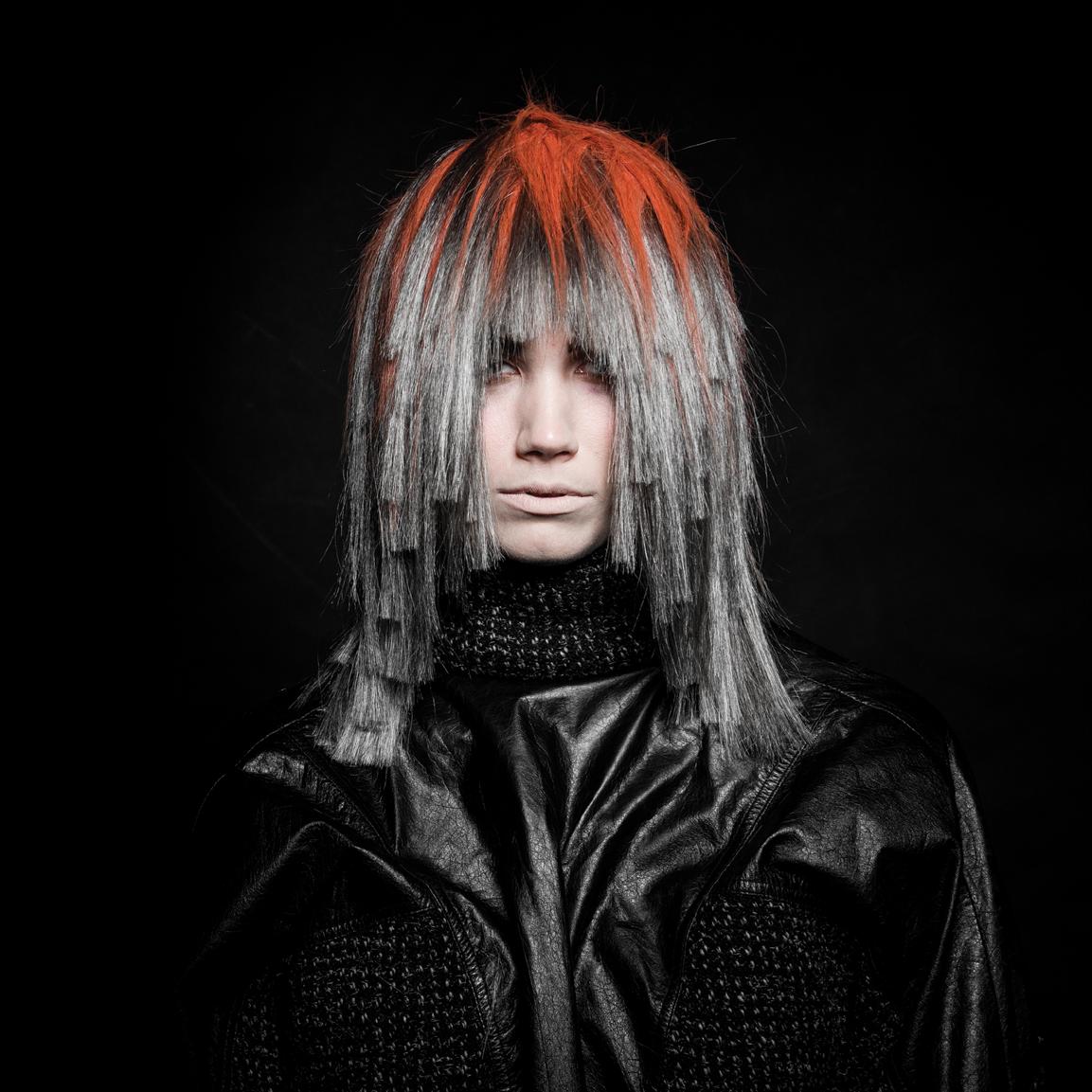
2 N. MARKET STREET, SUITE 100, SAN JOSE, CA 95113 / P: 408.293.4242 / UMBRELLASALON.COM

online www.content-magazine.com @ContentMag #weloveprint subscribe
CCONTENT
Issue 7.0
“Reveal”
February / March 2015
The Makers:
Cultivator
Daniel Garcia
Managing Editor
Flora Moreno de Thompson
Managing Photo Editor
Gregory Cortez
Designers
Daniel Millan, Omar Rodriguez
Gustaf Fjelstrom, Kevin Zittle
Circulation/Distribution
Leo Bevilacqua, Kereli Sengstack
Publisher
Silicon Valley Creates
Marketeer
Sarah Garcia
Senior Editor
Odile Sullivan-Tarazi
Production/Social Media
Victoria Elizondo, Kristen Pfund
Photographers
Scott MacDonald, Gregory Cortez
Stan Olszewski
Writers
Mark Haney, Brandon Roos
Nathan Zanon, Anna Bagirov
Chad Hall, Kate Evans
Michelle Runde
This issue reveals some up and coming people, their projects, and a few places you might not know about in Silicon Valley. Even if you are familiar with the selection of artisans featured in this issue, we present a look into their stories, their lives, and their journeys.
Enjoy.
Daniel Garcia The Cultivator
IN THIS ISSUE
Jeff Chang / Franco Uomo / René Lorraine Schilling-Sears / Cinequest 25
To participate in Content Magazine: daniel@content-magazine.com Subscription & Advertising information available by contacting Kereli Sengstack, kereli@svcreates.org
February ‘15-March ‘15

Feb. 6 Excision
Feb. 14 The Fresh Beat Band
Feb. 27 Bill O’Reilly & Dennis Miller
Feb. 28 WobbleLand
Mar. 3 Celtic Thunder
Mar. 21 Adnan Sami
Feb. 11 Dancing with the Stars Live!
Feb. 14-15 Disney’s Fantasia Live in Concert

Feb. 20-22 MasterPieces
Mar. 3-8 Rodgers & Hammerstein’s Cinderella
Mar. 19 In the Mood
Mar. 27-29 Rain
Feb. 1 25th Anniversary Chorale Concert

Feb. 14 Zeppelin Live!
Feb. 26- Schoolhouse Rock Live!
Mar. 1
Mar. 21-29 The Sound of Music
Feb. 7-22 Where Angels Fear to Tread
Feb. 17 Piper Kerman, Author
Mar. 9 Sr. Rosemary Nyirumbe
Mar. 14-15 Shostakovich: Gentleman Comrade
Mar. 27-29 Bodies of Technology
For ticketing and venue rental information, visit:

www.SanJoseTheaters.org
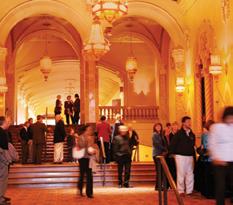

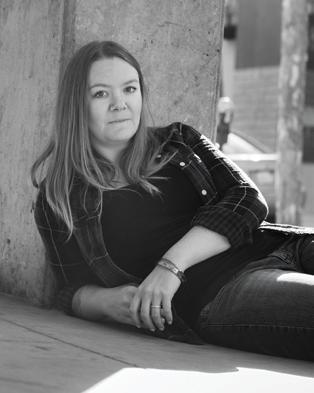

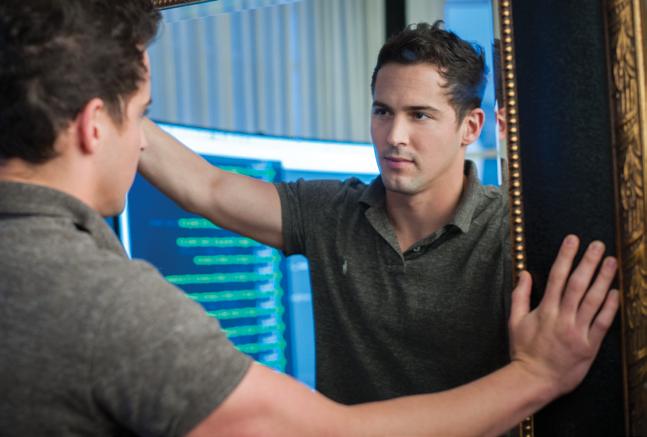
Content reveal 7.0 Content Magazine is a bimonthly publication about the innovative and creative culture of Silicon Valley published by Silicon Valley Creates. All materials in Content Magazine are protected by United States copyright law and may not be reproduced, distributed, transmitted, displayed, published, broadcast or modified in any way without the prior written consent of Silicon Valley Creates, or in the case of third party materials, the owner of that content. You may not alter or remove any trademark, copyright or other notice from copies of this content. For further information, to participate in the production or distribution, please contact us at, editor@content-magazine.com.
pg.
Feb/March 2015 San Jose, California
The Grid, Daniel Tocchini IV,
32
René Lorraine Schilling-Sears, pg. 12 DJ Shea Butter, pg. 66
Sister city 8 Pune, India CULTURE 10 An Art Park ART & Design 12 Artist, René Lorraine Schilling-Sears 18 Artist, Sid Enck, Jr. 22 Artist, Chris Elliman 28 The Grid, Daniel Tocchini IV Profiles 32 Cowgirl Bike Courier, Cain Ramirez & Amanda Muehlbauer 36 Cinequest 25 Years Halfdan Hussey & Kathleen Powell 40 Author/Professor, Jeff Chang Style 46 Franco Uomo, Franco Uomo 50 Bike Shop, John Agcaoili food 56 Red Branch Cider Company, Michael Faul 60 Dry Creek Grill, Holly & John Smith Music 64 The Trims 66 DJ Shea Butter Writings 68 Author, Cathleen Miller 70 Cinequest Guide 72 Contributors
Jeff Chang, pg. 40
Taco de Ojo
by Latino Toons Collective
Featured Artists: Enid Balam (Cuernavaca, Mexico), Muriel Bellini (Buenos Aires, Argentina), Matías Bergara (Montevideo, Uruguay), Miguel Det (Lima, Peru), André Ducci (Curitiba, Brazil), Charles Glaubitz (Tijuana, México),Raúl III Gonzalez (Ciudad Juarez,Mexico/El Paso, USA), Tomás Ives (Santiago, Chile), Luto (Cali, Colombia), Cristian Mallea (Moron,Argentina), Marcelo Mosqueira (Buenos Aires, Argentina), Juan Nava (Mexico City, Mexico), Rita Ponce de León (Lima, Peru/ Mexico City, Mexico), Javier Medellin Puyou "Jilipollo" (San Luis Potosi, Mexico), Jorge Pérez Ruibal (Lima, Peru), Marco Tóxico (La Paz, Bolivia), Renzo Vayra (Montevideo, Uruguay) and Oscar Zalles (La Paz, Bolivia).
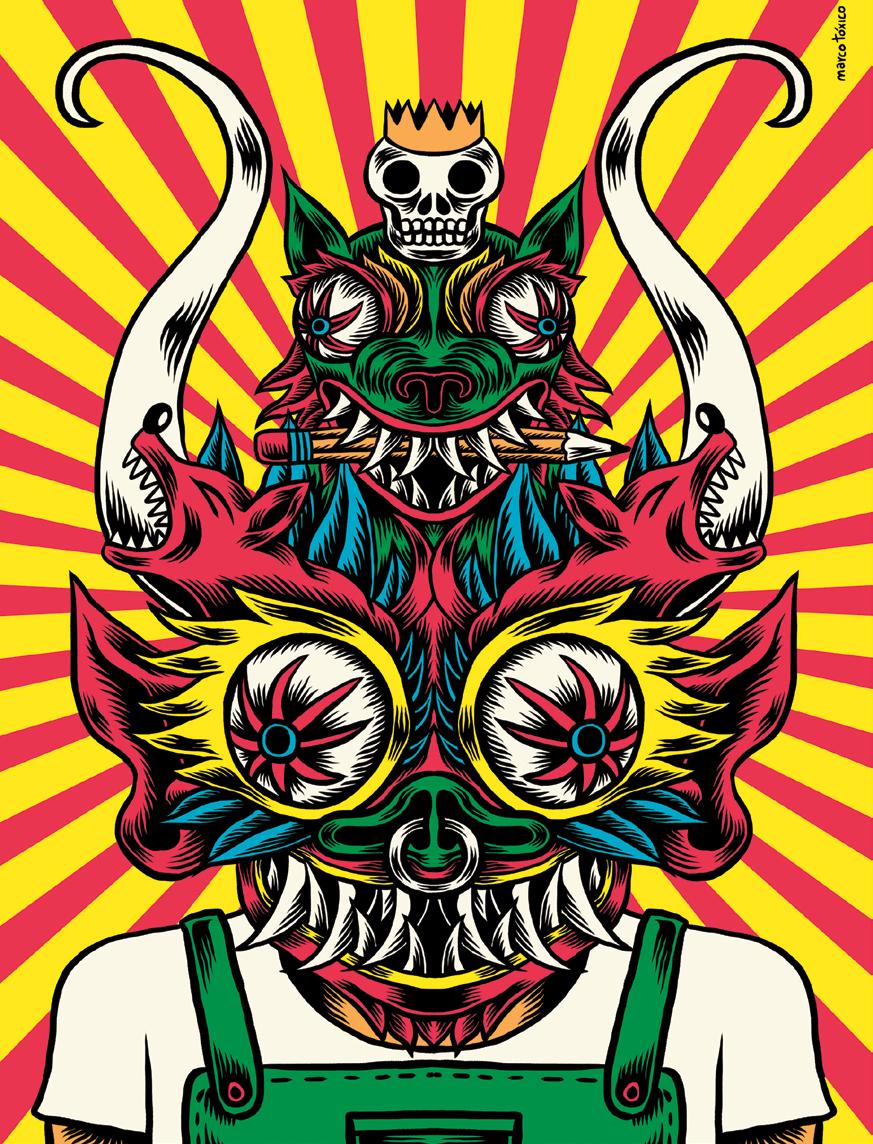
presents Gallery hours: Tuesday - Friday Noon–7pm, Saturday Noon–5pm & First Fridays 7pm–11pm Anno Domini // the second coming of Ar t & Design 366 South Fir st Street, San Jose, CA 95113 www galler yAD com 408 271 5155
E x h i b i t i o n : F e b r u a r y 6 – M a r c h 1 4 , 2 0 1 5
sister cIties
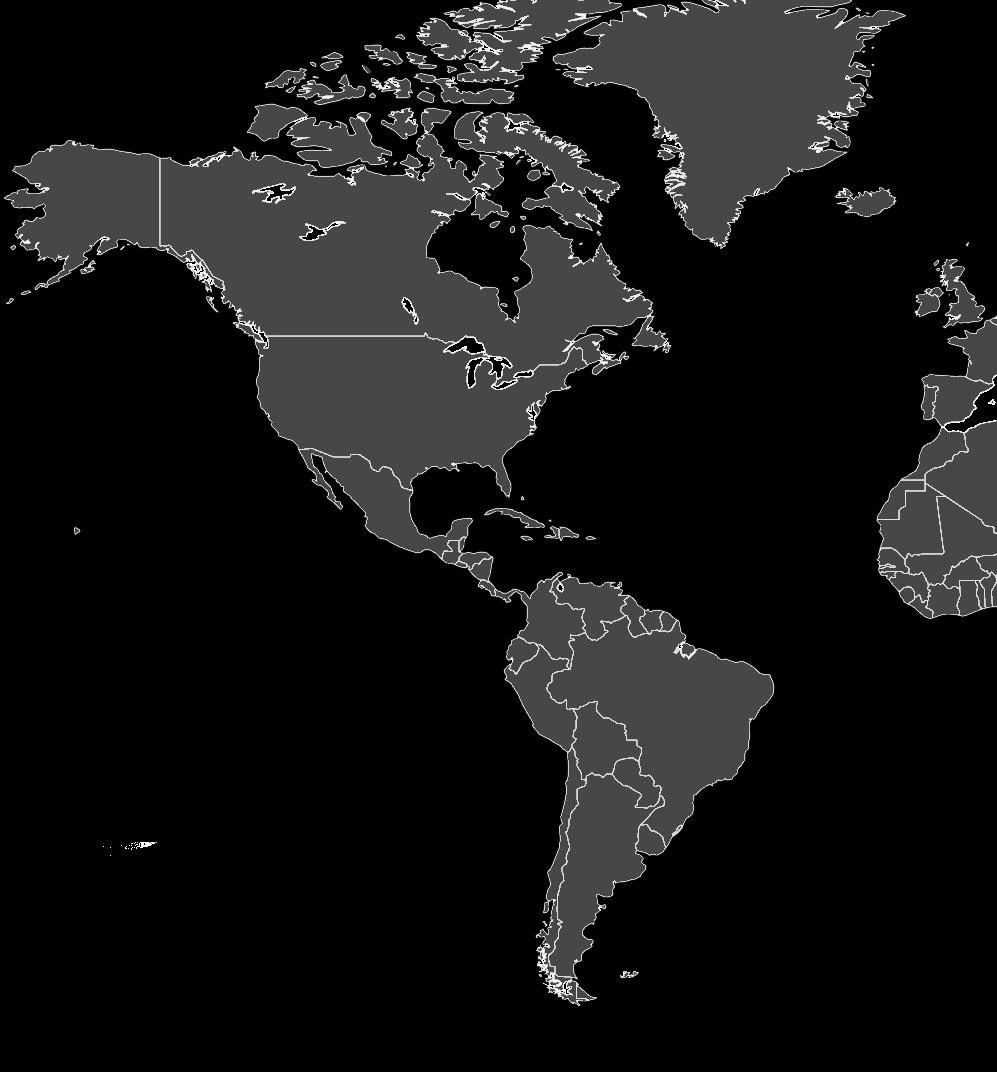
President Dwight Eisenhower established the sister city program in 1956 to foster global awareness and peaceful relations. For the next six issues, a design team from one of our city’s sisters will present their view of their home town.
Pune, India
Written by Poizon Ivy TaTtoo Studio
Queen of the Deccan, Oxford of the East, and cultural capital of Maharashtra, Pune is a city with a future that promises to be as rich and complex as its long history. Its name derived from Punyanagari (City of Virtue), Pune dates back perhaps as early as 937 CE. Today, Pune is the eighth largest metropolis in India and the second largest in the state of Maharashtra.
The Pune district is marked by beautiful terrain and magnificent architecture, a testament to the glories of centuries past. Modern-day Pune is the center of traditional Marathi culture, in which education, music, the arts, and theatre are honored. Pune is home also to one of India’s oldest universities, and its numerous colleges attract national and international students alike, hence its reputation as the “Oxford of the East.” In recent decades, though, with its growing IT industry, technological Pune has been on the rise as well.
Points of Interest
Pune is filled with architectural wonders. Your first stop along a tour of these might well be Shaniwar Wada, a stately palace built originally as the residence of the Peshwas. Its foundation was laid by Bajirao 1 in the year 1730 AD and construction was completed in 1732 AD, although his successors later added fortifications such as bastions and gates, as well as refinements such as court halls. The palace was largely destroyed by fire in 1827, although the massive walls survived and the 21-foot high palace door, known as Delhi Darwaza, yet remains. Shaniwar Wada stands today as a monument to the Maratha culture, its architectural design showing influences as well of both the Mughal and Maratha styles.
San JOse’s Sister Cities
San José, Costa Rica
Okayama, Japan
Veracruz, Mexico
Tainan, Taiwan
Dublin, Ireland
Pune, India
Ekaterinburg, Russia
Pune retains its old-world charm and its many quaint characteristics—the omnipresent cyclists, tum-tums (rickshaws), and a daily siesta hour that is taken very seriously indeed—most particularly in the historic city areas located in the center of the modern city. When you visit, a tumtum ride is a must-have experience.
The culture of Pune is broadly diverse. Marathi is the official and most widely spoken language in the city, although English and Hindi can be heard as well. Surrounded by verdant hills and beautiful lakes, Pune has a temperate climate and is among the greenest urban areas in the country.
Next up on your tour: Aga Khan Palace, built in 1892 by Sultan Muhammed Shah Aga Khan III and considered to be one of the greatest marvels of India. Built originally as an act of charity by a sultan who wanted to assist those left destitute by famine, the palace today is closely linked to the Indian freedom movement, serving as it did as a prison for Mahatma Gandhi and others.
Constructed by Nanasaheb Peshwa in the 18th century, Saras Baug features the scenic Parvati Hills as background. The exquisite Saras Garden, replete with elegant fountains and lush green lawns, houses a temple constructed in 1774 by Madhav Rao Peshwa in dedication to Lord Ganesha. The garden is a popular walking and jogging destination, and it serves also as a beautiful evening and weekend spot.
8
The Dagadusheth Halwai Ganapati Temple was founded in 1893 by Dagadusheth Halwai, a wealthy sweet mart owner. Halwai had lost his son the previous year, and at the request of his guru, he created murtis (images) of Ganesha and Dattatreya. Situated in a beautiful 32-acre campus, in Koregaon Park, the Osho International Meditation Resort Ashram of Bhagwan Rajneesh (Osho Ashram) is a resort for meditation and yoga. It attracts large numbers annually of the followers of Bhagwan Rajneesh.

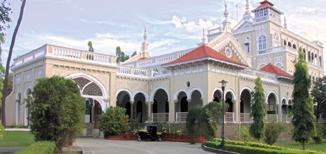

Dining
With all that sightseeing, you’ll be ready for a little refreshment. The cuisine of Pune is as varied as its population. Local musttry foods are puran poli, an Indian dessert bread; misal pav, a hot and spicy delicacy of special curry mix and bread; bhakarwadi, a local crunchy snack; and mastani, a mix of milkshake, ice-cream, and dry fruit. Many chaat delicacies, like bhel puri, dabeli, and S.P.D.P., are available both as street food and in the restaurants.

And speaking of restaurants, the local populace, known as Punekars, are foodies. For a selection of fine restaurants and nightspots, head over to Jangli Maharaj Road (also known as JM Road) and Koregaon Park (also known as KP).
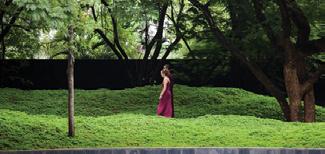
Shopping
There are malls in most areas in the city, where most international brands are easily available. However, if you are looking to pick up traditional Indian wear or souvenirs, street-shopping in local markets offers the best bet. You might try Laxmi Road, in the historic city. (Hint: for bargains, head over to Tulsi Baug.) Or Mahatma Gandhi Road, also known as MG Road, the commercial hub of an area known as Pune Cantonment.
We are a professional tattoo studio in Pune, featuring experienced tattoo artists, professional service, and unique designs. Our clients are our brand ambassadors.

We provide patrons with custom inking: portrait tattoos, unique Devanagari (Indian) tattoos for mantras, and more. Tattoos have always been an integral part of Indian culture, and here in Pune, the cultural capital of the state of Maharashtra, the art of tattooing has a lengthy and venerable history.
facebook: PoizonivytattooStudio poizonivytattoos@gmail.com

9
Poizon Ivy Tattoo Studio
Image provided by Poizon Ivy Tattoo Studio
Temple 250 Shivaji Road Budhvar Peth +91 202 447 9222 Open: Daily, 6am to 10:30pm
4. Dagadusheth Halwai Ganapati
Resort Ashram 17 1st Lane, Koregaon Park +91 2066 019 999 Open: Daily, 6am to 12am 5 4
5. Osho International Meditation
17 Koregoan Park +91 20 2612 6867 Open: M-F, 8am to 5pm Visit Duration: 2 to 3 hours
1. Shaniwar Wada
Pune Nagar Road +91 20 26880250 Open: M-F, 8am to 6pm Visit Duration: 1 to 2 hours
2. Aga Khan Palace
2170 Sadashiv Peth +91 20 20242022 / 20242132 Activities: Daily, 5:30am to 7:15pm 3 2 1
3. Saras Baug
An Art Park Bounded Only by Imagination
Written by Mark Haney
Urban parks come in all shapes and sizes. Some are created by famed architects and take years to complete. Others are created instead through an outpouring by the community. But however first envisioned, however created, these airy, open spaces, when done well, give respite from the densely packed terrain of urban life. Undeveloped land is becoming increasingly difficult to find in Silicon Valley, and yet there are still lots here and there that defy urban expansion. These lots are often forgotten by all but those who live in the surrounding communities, who might wish for a better neighbor than an empty dirt parcel littered with trash.
One such space sits between South 2nd and South 3rd streets, directly under highway 280, passed over by tens of thousands every day, most of whom little suspect the existence of this hidden gem lying beneath the road they travel. Unlike its twin, between South 2nd and 1st streets, converted now to public parking, this abandoned area is seldom given a second glance. Yet this neglected patch of dirt, tucked underneath a freeway, is simply waiting for its creative potential to be unlocked. And that potential just might be as an art park, created by the boundless imagination of the SoFA community.
The limits of art are determined only by the imagination, and the capacity of this art park would expand to the breadth of the community’s imagination. The SoFA district has thrived as an arts center for San Jose specifically because of an imagination both rich and fertile. An art park designed by
the SoFA community would enhance not only the surrounding area, but the entire city as well. Imagine one of San Jose largest murals, spanning a small city block, its canvas the freeway ceiling overhead. Imagine a small stage for live music and poetry readings. Imagine not just graffiti artists and painters plying their trades, but sculptors as well, molding or welding large pieces on-site without the restrictions of walls and ceilings. Imagine large installations being assembled for festivals like Subzero and Zero1. Even the ground could be reformed to create multiple levels, creating different perspectives of the park from different viewing points.
In cities like Austin and Eugene, city officials approved graffiti art parks, giving artists a legal canvas on which to create public works. That same idea could be applied here, with perhaps two or three walls devoted exclusively to graffiti. This would allow graffiti artists an outlet for what is typically a dangerous and illegal enterprise. Artists are always looking for space and canvas on which to apply their skills, and an art park would provide that space, that canvas—and more. It would provide also a place for artists to gather and collaborate. And to share that collaboration with the community.
Because, of course, the benefits of such a park extend well beyond providing a workspace for local artists. Such a park would also give art back to the public. Art can be remote and elitist, but what the art community in San Jose has captured with art walks and festivals—the full and free expression of art in an accessible
form—would continue now to thrive in a public art park. The art would be open to all, not locked up in a gallery, but out on the street, unloosed and unbridled. Art in the park would also enable artists to display different conceptions of art and art in the making. This park would provide a forum for artists and observers to interact throughout the creative process, to share ideas, to learn from one another. And it is through collaboration and community that ideas and movements are born.
Adding a unique urban art park to the burgeoning downtown landscape would be a labor of love, continuing the transformation of the SoFA neighborhood. As The Pierce and other apartment projects begin to pop up along South 1st street, a park in the area becomes even more of a necessity. We ought not to pass up this opportunity to turn unused land into a collaborative, creative working space within the urban environment. Through our collective imaginations, this unused and trash-littered space could become a place instead of beauty. An asset, rather than an eyesore.
10
Adding a unique urban art park to the burgeoning downtown landscape would be a labor of love, continuing the transformation of the SoFA neighborhood.
Thinkbiggersanjose.com

11
RENÉ LORRAINE SCHILLING-SEARS HER VISION, HER VOICE
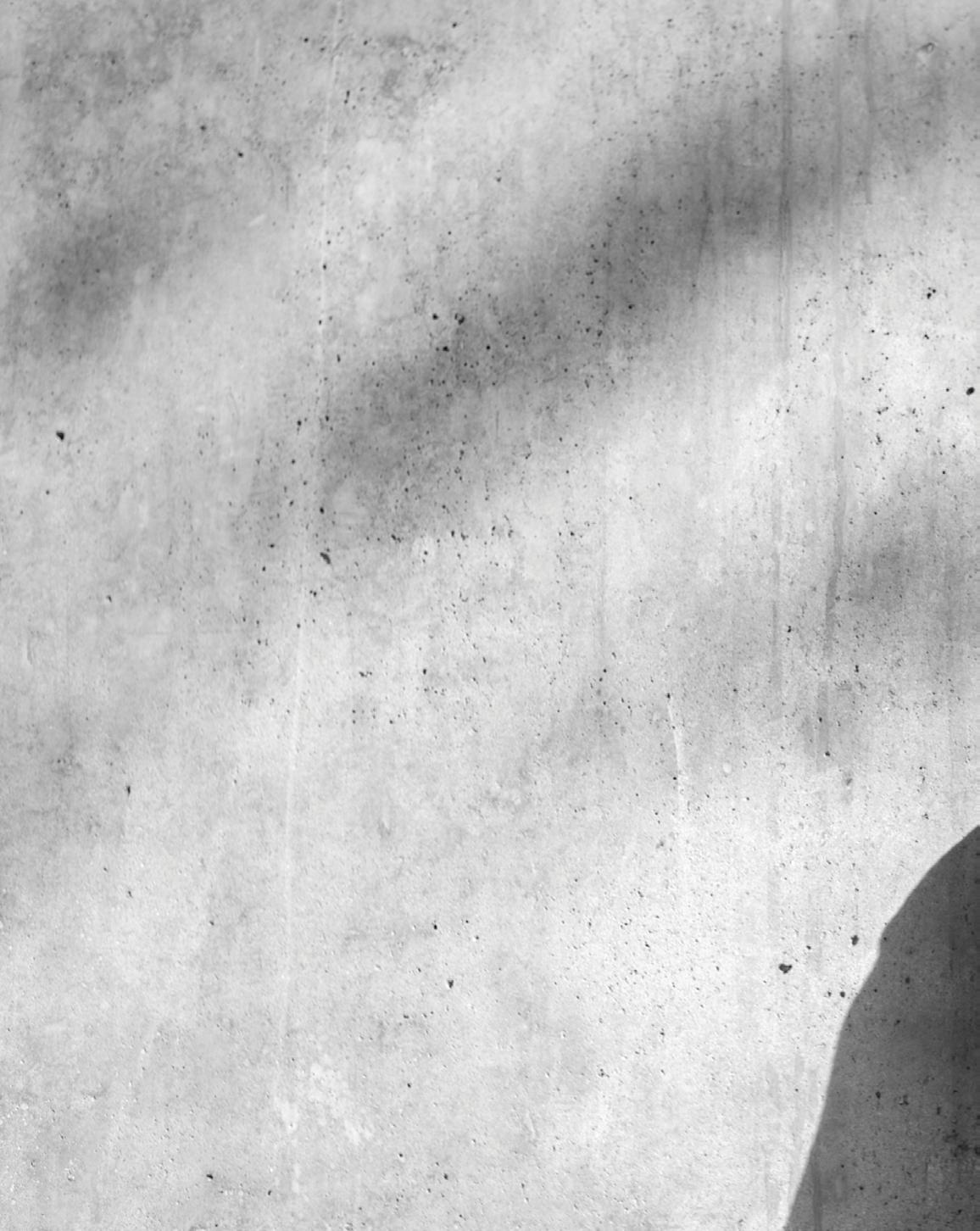
René Lorraine Schilling-Sears, a graduate of San Jose State with a BFA in Pictorial Arts, has moved from oils to watercolor and pen, giving a voice to what she sees.

12
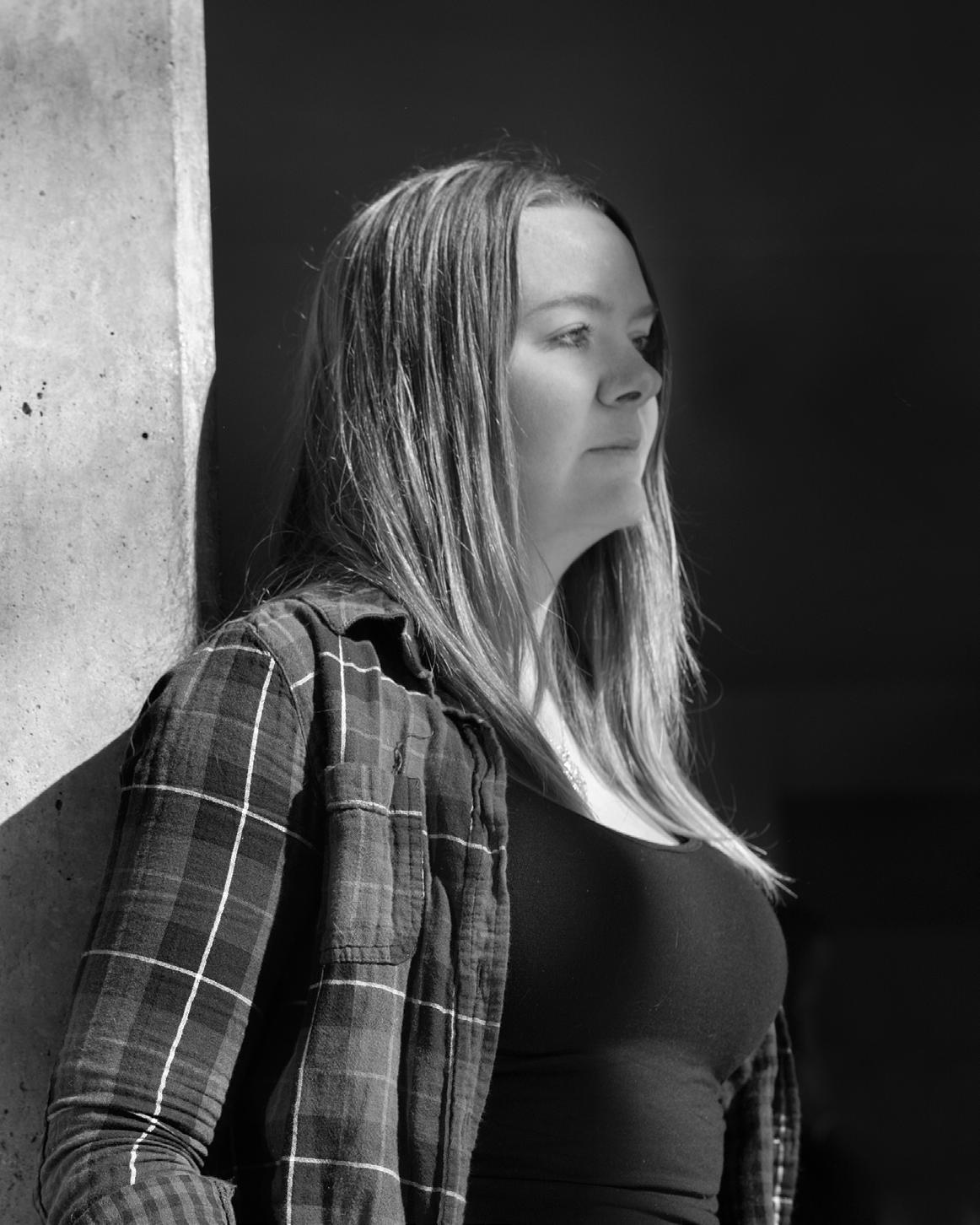
13

Was there a time when you had that “aha moment,” when you released your voice?
Yeah, absolutely. I had an instructor when I was at San Jose State who really got through to me. It was one of those things where you’re working on a painting and you finally see something that you hadn’t felt for decades. It finally just happened on the canvas.
Do you remember what that painting was?
Yes, I still have it too. I was working on my BFA show. My whole series was about body art, tattoos, piercings, things like that. That’s what I had been working on for the last two years at that point. It was a single fingernail. I was working on painting a hand. It was a single fingernail, and it was like, “Oh, this is what I want to do forever.”
When you look back at that piece, what’s your feeling about it?
I am in love with that piece so much that I feel like I’ll never be able to top it for myself. I’ve been offered a lot of money for it. There’s no way. It feels like my firstborn child, because I had such a connecting moment to it. It’s going to stay with me forever.
What was that about? Was it the type of technique that you used?
That’s hard. That’s a hard thing to put into words. At that moment, I felt I finally believed in myself with the title of “artist.” I was satisfied with the work that I’d done to the point where I felt like I could finally own the title artist, because that is always a struggle.
When you grow up in the Bay Area with a lot of amazing artists, you see so many paintings and artworks and people really making it happen. You think, “How am I ever going to compete with them?”
You have three different styles in your portfolio: oil, pencil, and watercolor. Which is your favorite?
I prefer watercolor and ink, which is crazy, because when I started painting, I never thought that I would do watercolor or watercolor portraits. It was the furthest thing that I thought I would ever be interested in. I was always just an oil lover and a canvas lover, but I think there’s something very intimate about sitting down with watercolor and ink, something that seems more personal. I like that. Oil is fun, too, but at this point to me...I’m just not personally as connected to it anymore.
Your watercolor ink portraits have a very unique aspect, with the subjects’ faces missing. I hear it is because of a degenerative eye disorder, is that right?
I have neurological issues. I have a cyst in my brain that causes balance issues and visual disturbances. The left side of my temporal lobe fires at half the rate that the right side does. There’s some disconnect there. Also, I have holes in my vision.
Some days, it’s like I’m looking through a wheel of Swiss cheese. It started in 2011. The doctors still are not really sure what it is. The holes in my vision, they’re not really sure where it stems from. They think it’s related to the other things that are happening. It’s really difficult to explain to people and hard to convey what I am going through, so I really wanted to put that on paper.
Why are you choosing this particular medium—pen and watercolor—for these portraits?
One of the reasons I do pen and watercolor in the same piece is because I feel a lot of times when I can’t see very well, it’s hard to feel grounded. I use the watercolor to show and convey that whole feeling that things are happening. When you work with watercolor, things will just happen that you can’t pick up off that paper. You can’t wipe it off. That’s how I feel with these spots in my eyes. They’re not going away. I can’t wipe them away. The hard lines that I use, that are more pencil or Micron pen, are my way of conveying those moments that are calm, that say “Everything is in place.” That’s how I’m trying to meld both of those together.
How does it feel then, when people are attracted to your work and find out your story? Is there a little bit of insecurity or concern? Are you wanting to share it?
Personally, I feel that things are less scary when you talk about them. On the one hand, I wouldn’t put the story out there, but on the other, when I did the show here, I titled it with the condition that I have. It gave me the chance to talk to 30 people—strangers—about it.
Putting it out there is easier because when I talk about things, I feel like they’re less scary. They don’t seem as crazy. At the same time, I don’t want my work to be all about my condition. I don’t want people to only pay attention to it because the story has a really personal health issue involved.
I imagine you don’t want your health issue to be the reason people notice your work, but it is part of your story. I was very attracted to your work, knowing that you had neurological issues.
It’s hard. It’s a hard balance. I think, for the most part, people...like you just said, you liked it before you knew the story. I hope that continues, but at the same time, it’s also really cool. I’ve met some cool people who have similar conditions. They can see that within the art. They can relate to it.
You’ve had this current series. What are you working on now? What’s next for you?
I’m still expanding this series, but I want to bring more medical devices and machinery into it. I have a show coming up in the fall in San Francisco, so I’ve got about eight months or so to finish this body of work, or at least a couple new pieces. That’s what I really want to do. I want to bring the medical equipment side to it, just to evoke more of those feelings, and get more people to be able to connect with the pieces. A lot of times a portrait is a portrait, and you need something else in there to show or help along the thought process. I think the juxtaposition might be just right.
What’s the greatest lesson you’ve learned in life through your painting?
What I always come back to is a moment in college, where a professor told me to eliminate something from a painting, and I did it without even thinking. I hated that painting from that moment on. I could never get that piece back to what I wanted it to look like.
I always go back to that moment, in all sorts of experiences, and remember to always stop and think and not take somebody else’s opinion without really figuring out if it’s right for you. It’s interesting that I learned that through painting.
15
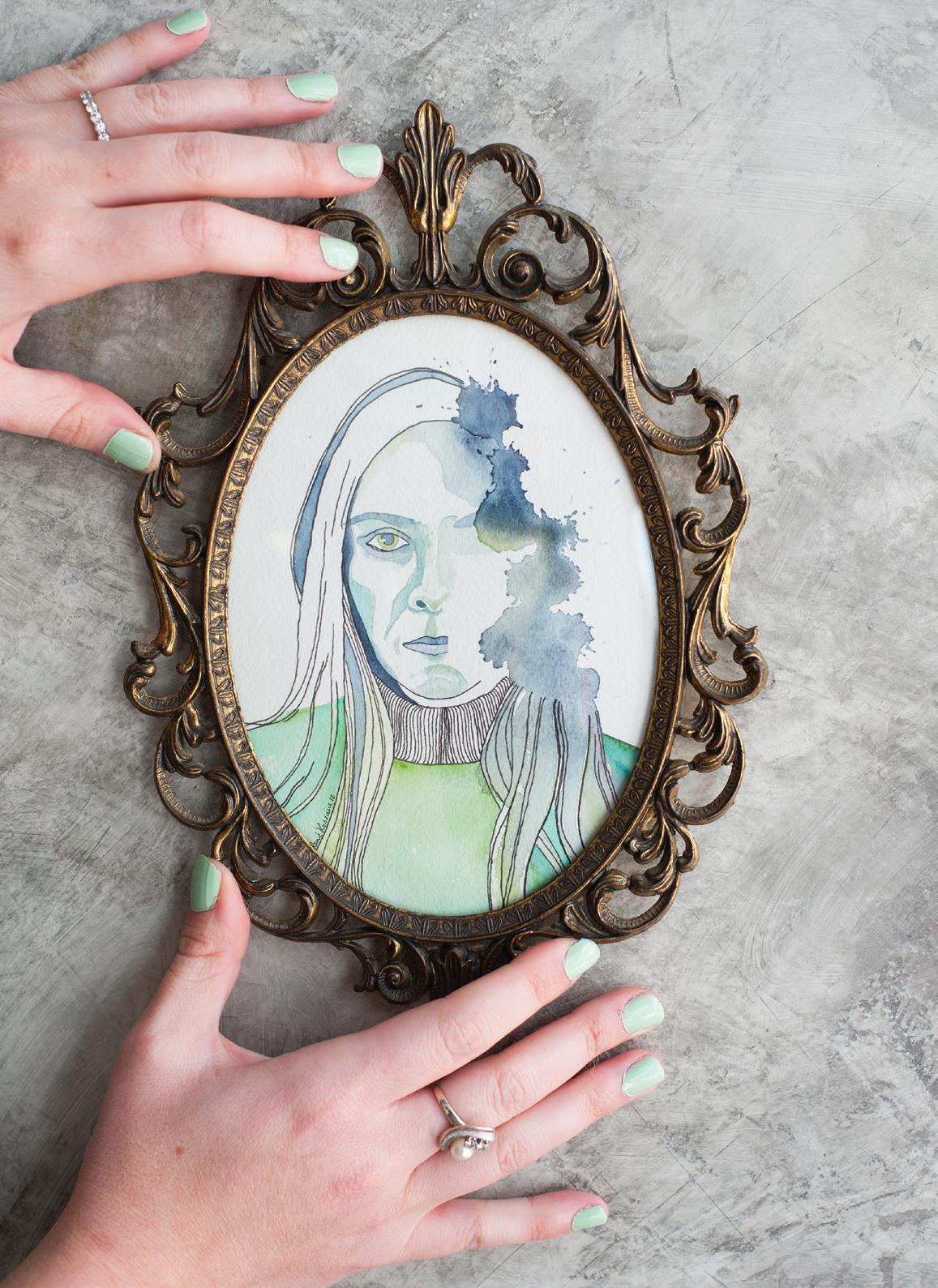

renelorraine 17
renelorraine.com twitter:
The Vibrant Mind of Sid Enck, Jr.
Written by Kate Evans Photography by Scott MacDonald
Sid Enck grew up in the Bay Area with a strong feeling that “art was in [his] life from day one.” His grandfather was an architect and interior designer and took Enck to his first art show in San Francisco. While his grandfather made sure he felt at home in an artist community, his mother was helping him find his place in her Native American one. She took him to pow-wows and wove together stories for him drawn from her Choctaw, Chickasaw, and Cherokee heritage. Enck, who often goes by the moniker, Little Lost Indian, says that her stories continue to inspire him today.
Enck’s style is clearly influenced by a Native American aesthetic, specifically Hopi, Navajo, and Apache, and is characterized by strong black lines and repeating geometric patterns. He explains that during a cross-country journey through the Southwest, he struck up a friendship with three Apache street artists and felt a deep and immediate connection to his own Native American roots. He had a moment of clarity, realizing “I want to create art that I really connect with and that I enjoy making,” he pauses, “that I’m in love with.”
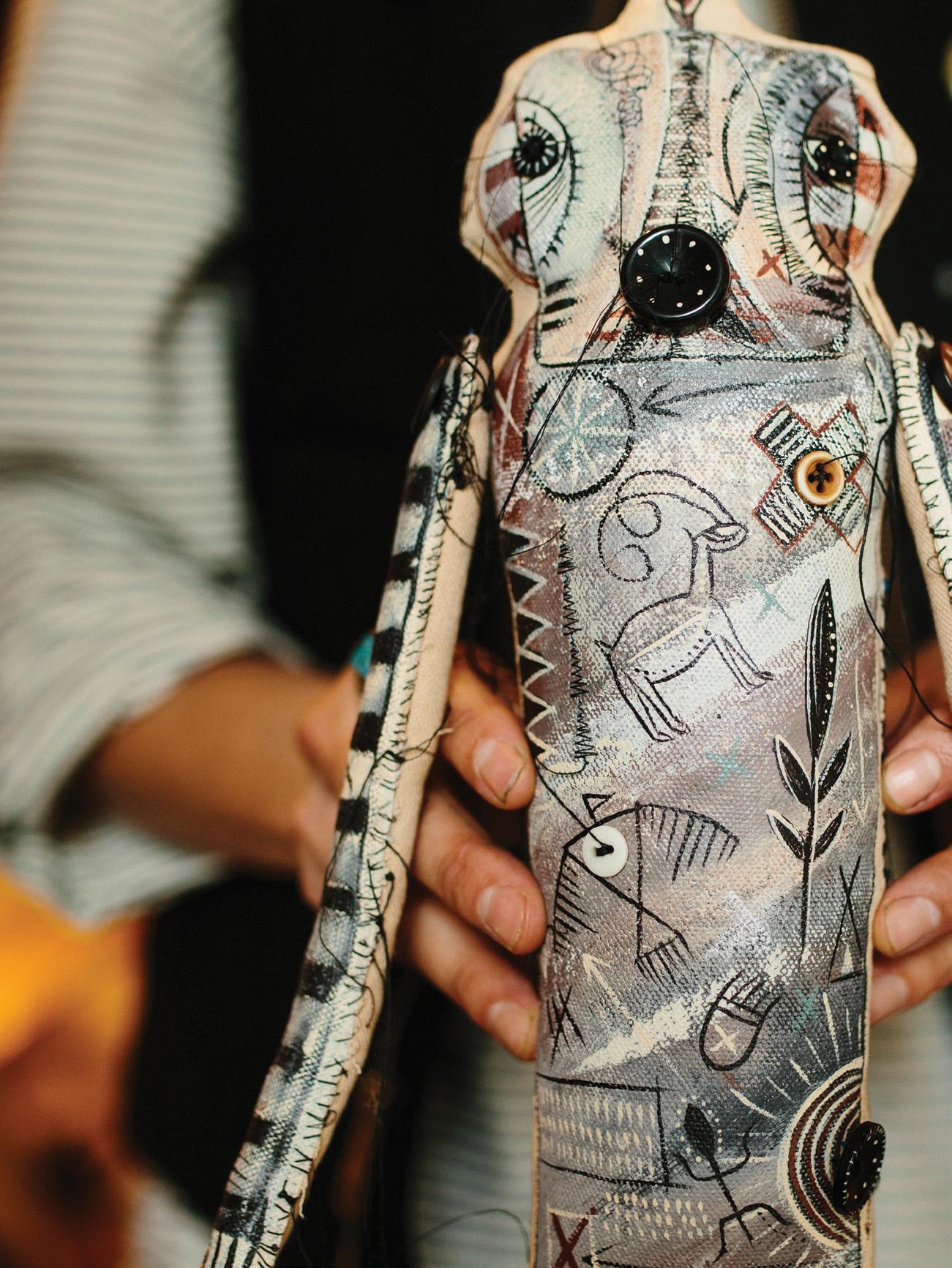
It’s not easy to categorize Enck, since he sees a canvas in virtually everything. He creates art that is wearable, portable, and utilitarian. His creations are practical, like his stylish print-screened T-shirts, but also fantastical, like his signature big-eyed Tribal talisman plush dolls. He finds beauty in taking things apart and manipulating the pieces in unexpected ways. He takes piles of his own photographs and cuts them into triangles, sewing them together in an abstract collage of color that becomes
part of a larger art piece. He is proud of his ability to create something new from items that others ignore or throw away.
Enck’s vibrant energy comes through in his art. His drawings almost have a frenzied quality, with heavy black lines that look like they have been retraced a dozen times. His designs are a deliberate blend of orderly repeating graphics and freehand scrawls, which he then applies to canvas, wood, clothing, bags, pottery, skateboards, whatever it is that might inspire him. Enck’s not afraid to use bold strokes with a can of spray paint or delicate flourishes with an ink pen. The end result is an art piece that is approachable, yet unconventional, and always unexpectedly beautiful. You look at one of his creations and know immediately that it came from the vibrant mind of Sid Enck, Jr.
When Enck’s not creating, he’s skating, or traveling in his modified van (complete with loft and kitchenette), or escaping to the redwood forests of Big Sur. He’s always moving, always finding new outlets for his creativity. He and his girlfriend have recently started a screen-printing company called Black Arrow Printing, which is already showing signs of being a big success, and he has his first solo art show (in a long while) this March at San Jose’s Arsenal. This coming year also includes plans for a cross-country journey, which for Enck means a chance to gain inspiration, to “meet new artists and see different things around the country.”
And yet, with all of his motion and travel and wanderings, he always finds his way back home. “Yeah,” he says, nodding, “there’s nothing like the
Bay Area.” He loves the freedom, the diversity, the vibrancy. He is part of a thriving creative community here, explaining, “I have a lot of amazing artist friends who always keep me on my toes, keep me on my feet.”
For all that he has accomplished and all that he has planned for the future, Enck is a remarkably humble creative force. He talks about his art as if it’s inevitable. “It’s all I think about – I just wake up and start creating,” he says.
When asked what’s next, he smiles with his warm brown eyes and genuinely asks, “besides living the American dream?”
sidenckjr.com
store: littlelostindian.bigcartel.com
blog: littlelostindian.tumblr.com
littlelostindian@gmail.com
“I WANT TO CREATE ART THAT I REALLY CONNECT WITH AND THAT I ENJOY MAKING, THAT I’M IN LOVE WITH.”
18

“I GET ANXIETY WHEN I’M TREADING WATER.”
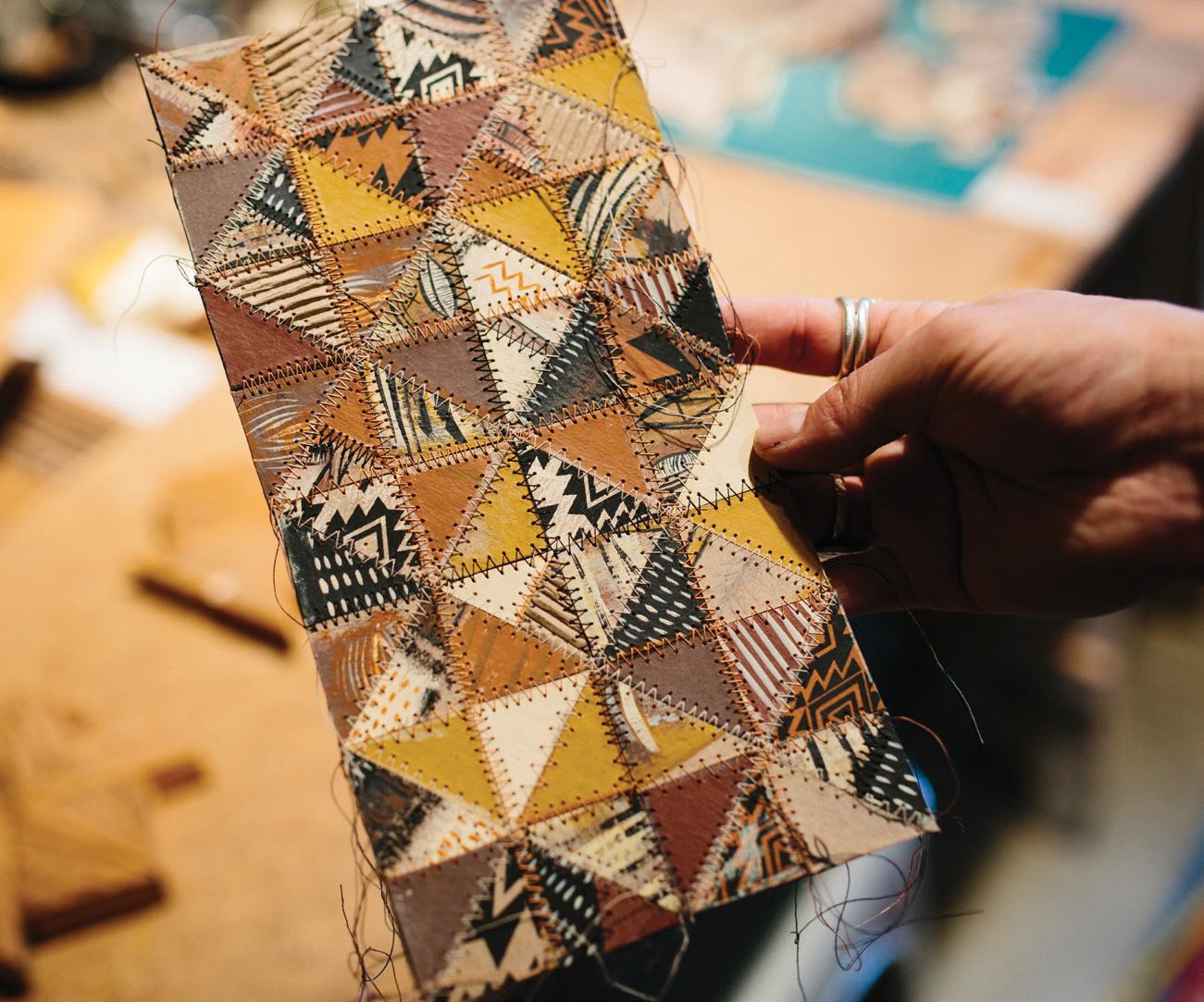

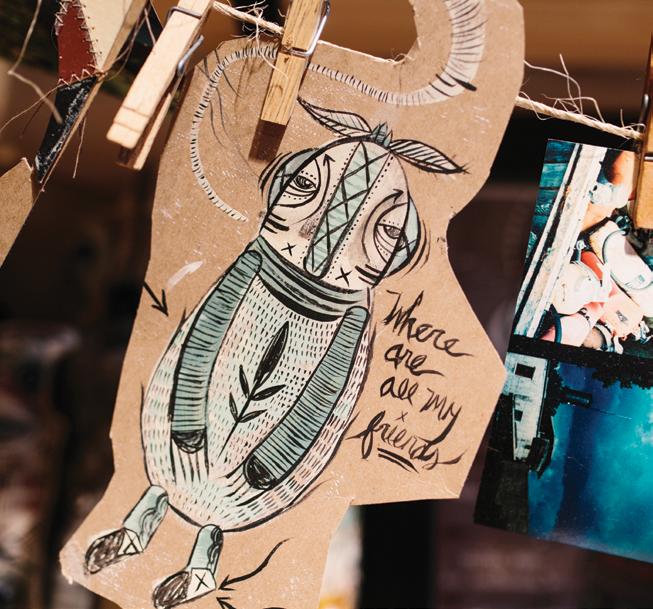
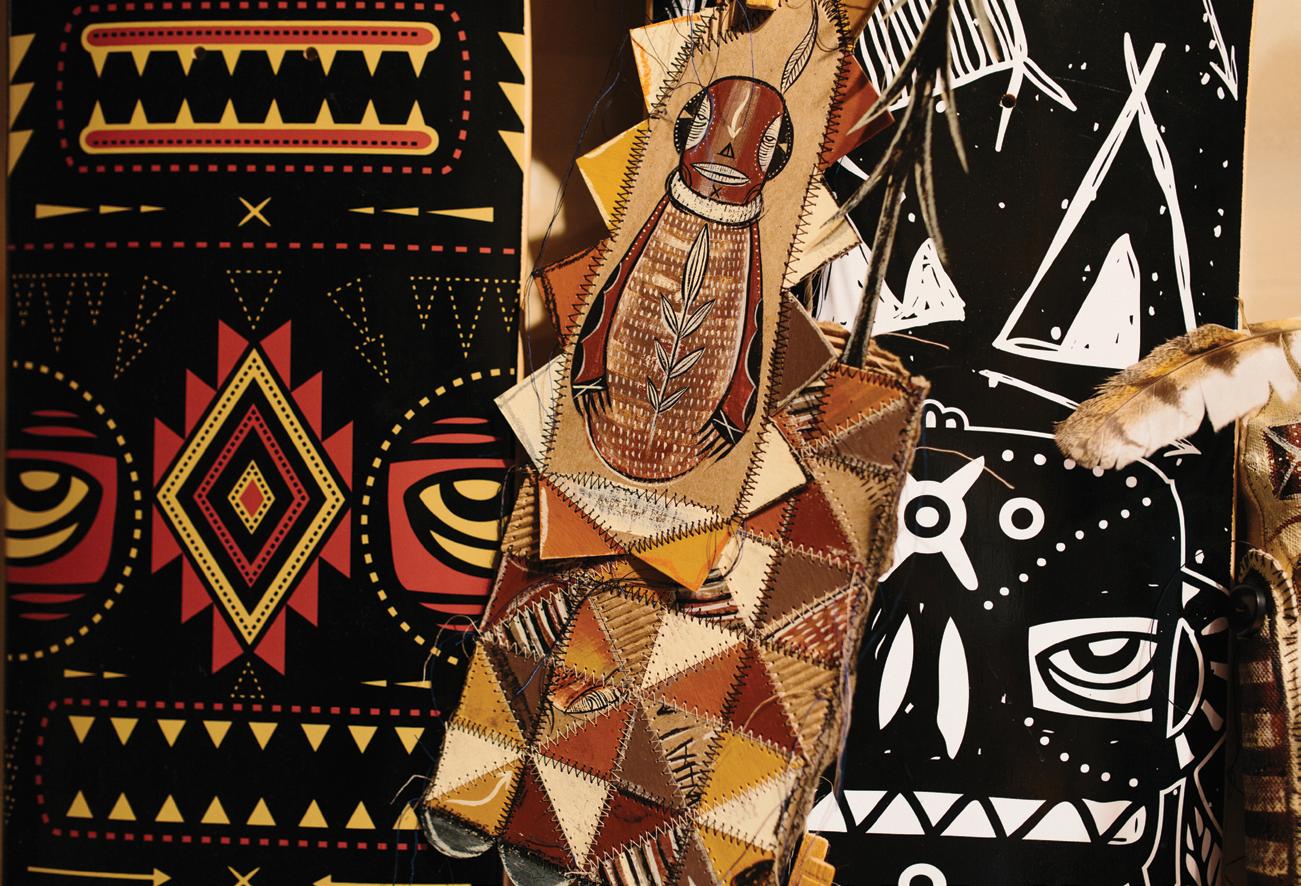

Chris Elliman moved to the US from England in his teens, when his father landed an industrial design position at Apple in 1985. Through his creativity, talent, and persuasive persona, he finds himself thoroughly linked to the creative culture and history of the South Bay and Downtown San Jose.

Disregarding high school, Chris landed in the middle of San Jose’s skateboard scene and began hanging out with Corey O’Brien, Steve Caballero, and Ray Stevens II (Faction

and Los Olvidados), the latter being one of the first people Chris met when he came to San Jose.
In the early 1990s, Chris found himself working at the now-defunct nightclub One Step Beyond as decor designer, occasionally DJ’ing with records he had acquired during his time as a display artist at the Tower Records that was on Bascom Avenue in Campbell.
Moving on to the Metro Newspapers as graphic designer, he met Chris
Esparza (owner of Naglee Park Garage and Giant Creative) and the two of them developed underground parties called the “King of Club,” which they used to co-found the club Ajax (pronounced “Ai-yax”) in 1991. Named after the Dutch football team, the now legendary South First Street club, formerly located above Cafe Stritch, closed in 1995.
Searching for what to do next, Chris nearly headed to Portland, Oregon, but was offered a warehouse space in the American Can building on South
22
5th and Virginia, which he has both subleased as an artist collective and used as a studio himself for the last 30 years.
In his studio, lightly littered with a design and visual history of San Jose and framed by shelves of albums, Chris speaks about his paintings. (We’ll save his cycling and graphic work for another time…)
“Life cycle”
I think I have the courage to make many mistakes, which allows me to grow from those mistakes. What I paint is life—my surroundings, what I see, people. I like to think that, in every one of my paintings, I am communicating about culture…I think paintings should say something. I’m not saying there’s anything wrong
with aesthetically pleasing paintings. Aesthetics is a great thing. It’s got its place. I’m OK with that. Sometimes I do things that are strictly aesthetic, but I like to think that most of what I do has got a social or a political charge to it, a psychological charge.
I’m looking at society and I’m looking at what is almost an illness or a psychological situation. I feel like I’m trying to paint a little bit of that into each piece, so there is definitely something behind every piece.
I like to say that most of these paintings—maybe all of these paintings—are like portals.

There’s a flat surface that you see, but what is really taking place is what is behind that surface. There’s a story.
With abstract painting, abstract art, you bring your story to it and it completes the paintings. I feel like everyone has a story and these paintings get completed with their stories.
It’s like truth. Everyone’s got their own truth. Truth’s ever-changing…
“systematic deconstruction”
This particular painting is not actually completed. My concept of finishing this painting is when someone purchases it, we’ll go to a target range and we’ll shoot. I’ll allow them the choice. They can shoot holes through it, which would be ideal. That way they have now become a part of this piece. Or we’ll allow the instructor or whoever it is to do the shooting [laughs] if they don’t feel like doing it.
23
life cycle
systematic deconstruction
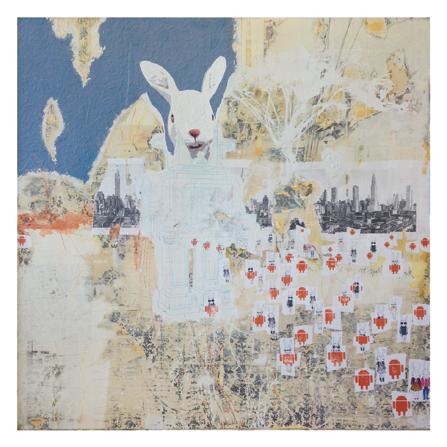

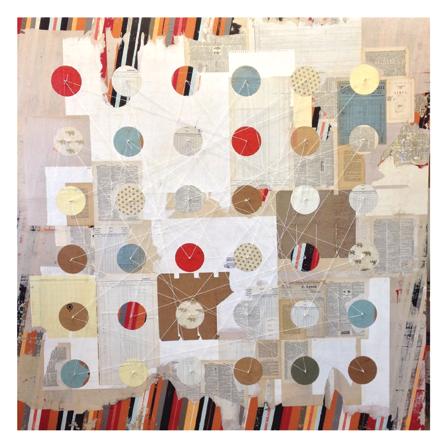
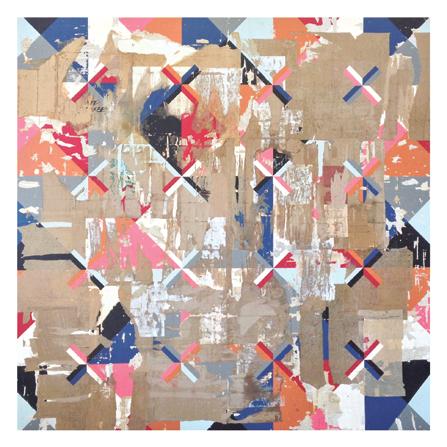
off with their heads
it’s our differences that should unite us, not divide us
serendipitous deconstruction no. 2: pussy riot voices of dissent
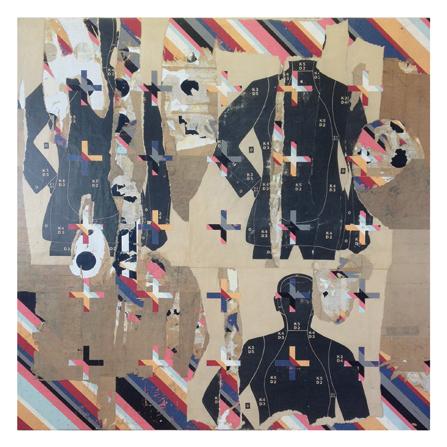
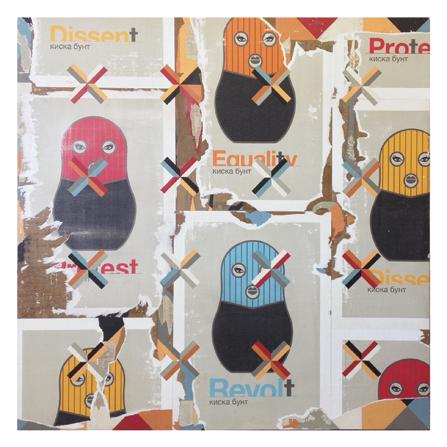
24
a visual discourse in non-objective cageian randomness
“America: Stars and Strikes”
The Mickey Mouse and the figures, which were a couple of friends who modeled for me, they represent for me...what was behind this is “American Apparel.”

You’ve got two young models, fairly innocent in their attire, which is just underwear, yet provocatively posed. In America, everyone’s trying to be a celebrity or successful, so there’s a fine line in Hollywood between starting out as an innocent Disney character star, and then moving over into pop music or movies. Those who “make it” are the stars. Those who don’t are the strikes.
The innocence is in the Mickey and Minnie Mouse. It represents what is
behind this American Apparel. There’s a fine line...that goes down the path of, “I didn’t make it in Hollywood but I became a porn star,” or “I became a sleazy magazine advertising model.”
For me, it’s just a hard hit on Hollywood and the media, and what drives people.
“a visual discourse in non-objective cageian randomness”
Right now, I have moved on to what is a “Cagean” philosophy, from John Cage, the composer, who was a Buddhist practitioner and who studied “randomness.”
I’ve been exploring John Cage and his thoughts about randomness in a few pieces. He composed music randomly
because he felt that was more natural, and I felt like that’s what I was doing. I read this book on John Cage so I could understand him better. I felt like there was a great connection. I was actually doing what he was talking about through some of these pieces. Then I thought I’d explore it a little bit further.
Then the X’s. Yeah, I created the X’s, so they’re all the same size. I cut them out and threw them down, and allowed them to land randomly. There are 27 X’s because I’m very fond of the number three. Those X’s were thrown down randomly, and wherever they land, that is the serendipitous part, the randomness. They just land, and I’m not going to dictate that.
25
america: stars and strikes

Those colors aren’t my favorite colors. However, I did have those colors. I had at some point chosen those colors. Since I have these pots of paint, I decide to randomly select this bunch of paints and looked at them and said, “OK, I’m going to use those.”
As a designer I’m fighting it a little bit, thinking to myself, “Oh, I wish I hadn’t had that color.” [laughs] But I’m going to go along with the experiment, exploring, and I’m going to allow that color to stay because that’s what Cage was doing.
“serendipitous deconstruction no.2: pussy riot”

I had loosely called it “Serendipitous Deconstruction” because I was deconstructing what I was building.
Serendipitously finding interesting things in the piece, and allowing what I thought was interesting to remain.
Each time I did something, I allowed the interesting portions to remain, so it was serendipitously deconstructed.
“The World is flat but it’s an un-level playing field”
This is geographical. It is all the countries of the “round of 16” of the World Cup, placed geographically.
Russia, Japan, Korea, Australia, Argentina, Chile, the United States, and Mexico—all connected to the nations they played against. Each game is strung up together.
I changed the colors in the spaces, but all of these shapes were created because of the outcome of the games. I mean anyone could have won the World Cup, right? Random.
That’s the eye of the artist—you’re able to recognize what is potentially going to become art.
27
christopherelliman.blogspot.com thethoughtfarmdesign.blogspot.com
the world is flat but it’s an un-level playing field
THE GRID
THEMSELVES
There are no problems, only solutions. For Dan Tocchini IV (aka D4), co-founder of The Grid, the problem with website development is that it needs more than a mere solution. It needs a revolution.

Dabbling in coding as a kid, Tocchini ended up going to UC Berkeley— doing the tech thing, studying computer science and applied physics. But Tocchini found his education too theoretical, not touching on anything modern or relevant. Uninterested after graduation, he found himself in diamond sales through a family connection. “It’s a lot like narcotics,”
he snarks. “It’s crazy. This guy gave me the product and said, ‘There’s a million dollars’ worth of goods, see what you can do.’” Tocchini discovered he had the ability to sell things rather well.
Tocchini was expanding his diamond sales throughout the Bay Area and needed an inventory system to track his product, so he developed a website to communicate with clients.
He started to request bids to develop his website. “It’s ridiculous,” he recalls. “It was $60,000 just to get started. What is this?” thought Tocchini. “This is much more profitable than diamonds. It was completely under my control. There’s no dealing with shipping, it was just pure abundance instead of scarcity.”
That was the first time Tocchini actually dabbled in web development or attempted to run a web stack. Tochini really fell in love with it and got hooked. So much so, that one weekend he just dove in. That Monday, Tocchini went into business. “I’m going to try and sell my services like web design services.”
28
Interview and Photography by daniel garcia
WEBSITES THAT DESIGN
“WHAT THE HELL IS A WEBSITE ANYWAYS?”
“AI WEBSITES THAT DEVELOP THEMSELVES” IS A PRETTY AUDACIOUS CLAIM, BUT DAN TOCCHINI IV AND HIS TEAM AT THE GRID ARE DETERMINED TO PROVE IT.

29
In 2006, Tocchini joined with a few friends to launch an interactive agency, but quickly became frustrated with the limitations of the websites they could deliver. Despite doing what they could to provide clients with an editable and functional content management system, their clients would still encounter problems.
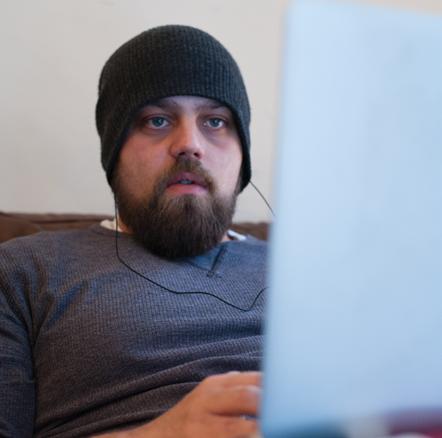


“We built tutorials in WordPress, we built a custom CMS, but they would always come back and ask, ‘How do we add YouTube videos?’ or ‘How do we install a plugin?” And when they tried, everything would break. It was just an annoying process. This idea of the website problem just hit me full on.”
Tocchini began searching for a better way to create and maintain websites. He developed an early prototype similar to Squarespace, a drag and drop website building platform. Still, it did not satisfy what Tocchini dreamed about. “The thing is,” Tocchini adds, “You sit someone in front of the interface where they can move a box around. They could choose a typeface. They could have a color wheel. All of a sudden, you’ve given them a baby Photoshop. They’re not good designers, so it’s just a recipe for just disaster.”
The Grid seeks to remedy this problem by moving people away from having to design or code their own websites. It frees them to interact with the web in the way we really
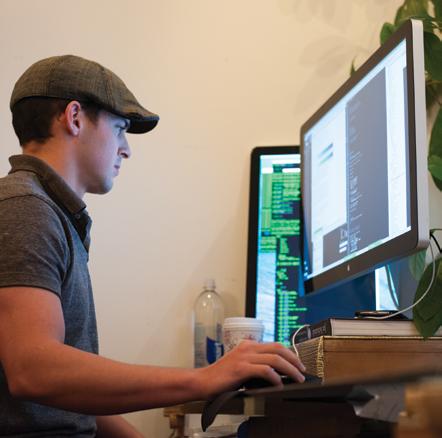
want to—to be more social. “Making connections,” Tocchini adds. “People connecting through content the way we are already used to on Facebook, Twitter, and Instagram.” But the Grid adds a customized touch that matches our personalities, and is styled as if a designer had put it together.
Simple, right? Like their promotional video declares, there’s a lot going on to make it work. Much of this is dependent upon two behindthe-scene systems. In its simplest terms, it is dependent on constraint solvers (the layout of the webpage) and a system of handling the code (managing complexity).
30
D4
Creative Director Leigh Taylor
The Grid crew.
Daniel Tocchini IV
To deal with the complexity of code, The Grid is expanding on a software coding language called Flow-Based Programming (FBP), invented by J. Paul Morrison in the ’70s at IBM. In short, FBP is built on the idea that code and repeatable tasks can be bundled into what are called ”nodes,” or visual buckets of commands. This type of coding is found in video game programing. By stringing together various nodes—task-buckets, if you will—you can manage really complex systems in a visual process, rather than a text-oriented one.
The Grid has been building on FBP with NoFlo, a FBP-based framework, which was developed by Henri Bergius
to move program development and coding from the text-heavy, matrix code jungle to a graphic, visual way of seeing the relationships and path of the coding program.
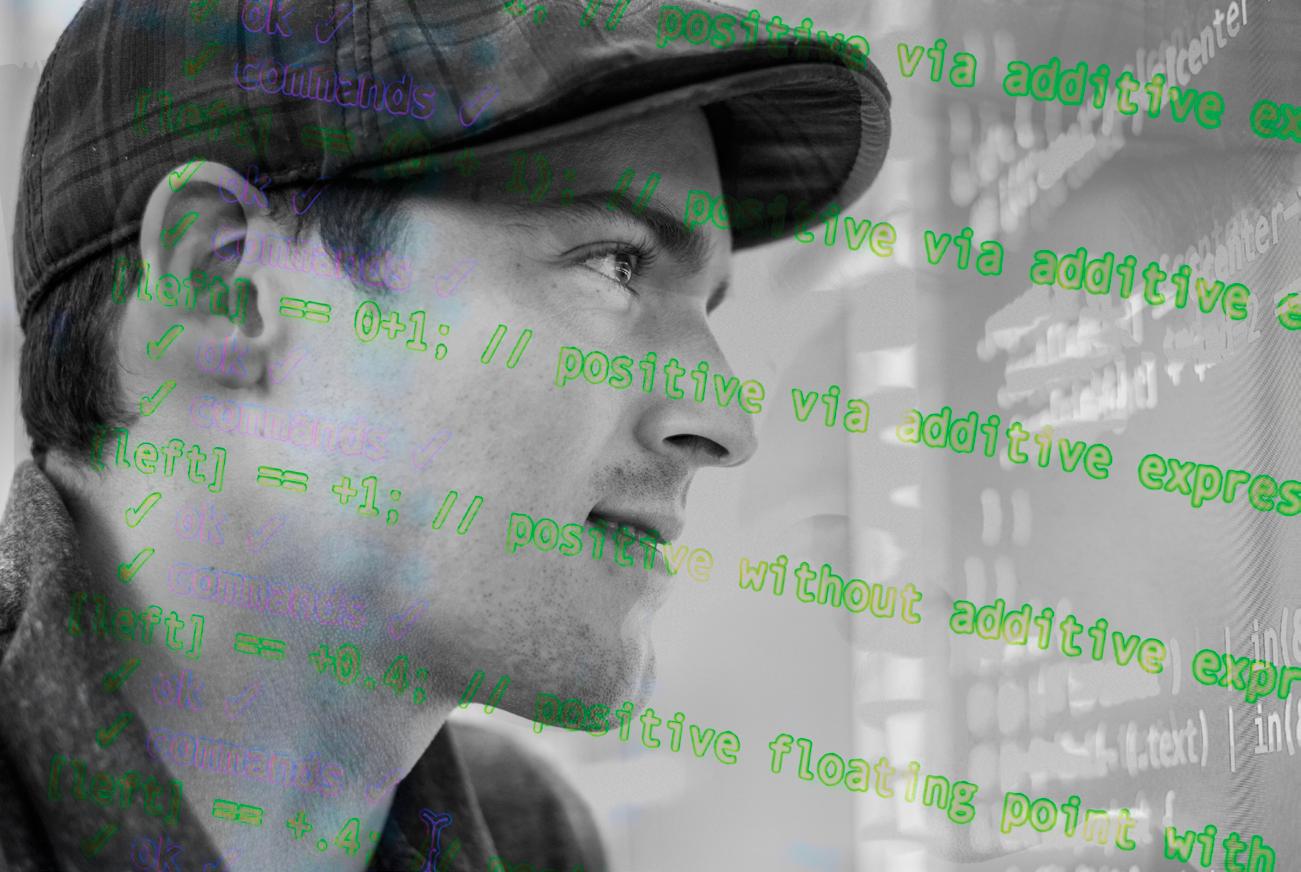
The other aspect to The Grid’s web revolution is addressing the traditional web page layout, which has been done using Cascading Style Sheets (CSS). Again, this text-oriented environment makes developing, updating, and problem-solving site issues mysterious and difficult. Tocchini and The Grid have developed Graphic Style Sheets (GSS) to make this easier. Based on Cassowary software, GSS deals with the algorithms of object placement and function in a layout the way a graphic designer might think.
This is important to The Grid because when you upload an image to your new Grid website, nodes will process the image. These will find and analyze faces. Are they smiling? Are there cat faces? Are there areas of low contrast in the image? What is the color palette of the image? What are suitable typography and colors for the image? What is the sentiment of text? To bring these to life, The Grid has to deal with the layout and style restraints, and the complexity of managing the information. These software advancements are the needed arsenal for a web revolution. Because, as Tocchini says, “When you add content on The Grid, we do a lot of things.”
thegrid.io flowhub.io noflojs.org
twitter: thegridio
31
“WHEN YOU ADD CONTENT ON THE GRID, WE DO A LOT OF THINGS.”
GIDDY UP COWGIRL (COURIER)
Written by Flora Moreno de Thompson
Cain Ramirez and Amanda Muehlbauer are pretty busy these days. As co-founders of Cowgirl Bike Courier, a bike messenger service out of San Jose, they have been working to keep their business running smoothly since it first opened about six months ago. “Now that we have a much higher volume of deliveries, [our couriers] have adapted gracefully to our growing demands,” says Muehlbauer, the company’s CFO. While she deals with the financial side of the business, Ramirez—CEO and bike courier—can be found making deliveries around the South Bay, delivering everything from Chinese takeout to CSA boxes to medicine.
32
Photography by gregory Cortez
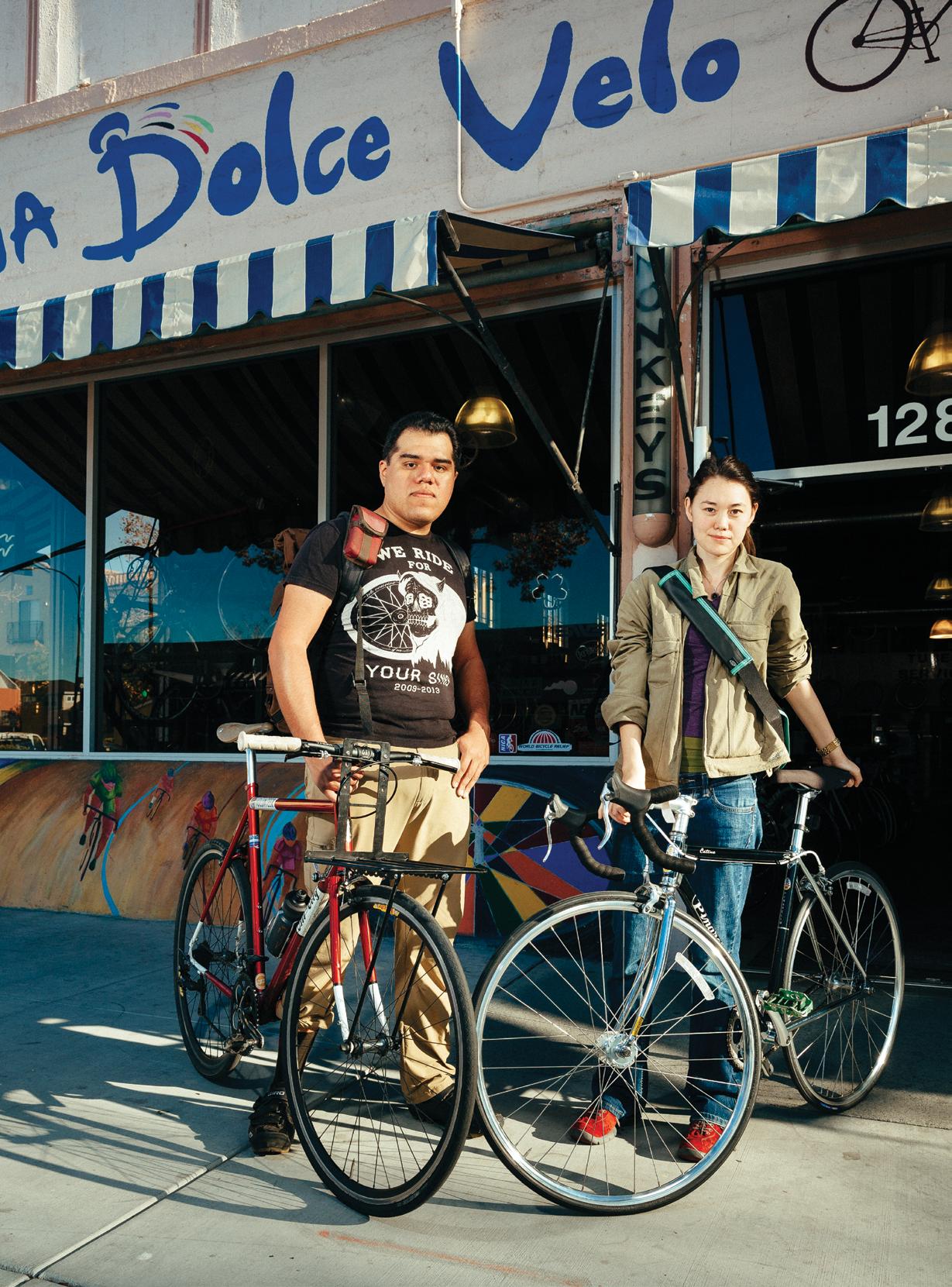 Cain Ramirez
Amanda Muehlbauer
Photographed at La Dolce Velo Bicycle Shop 1280 The Alameda, San Jose, CA 95126
Cain Ramirez
Amanda Muehlbauer
Photographed at La Dolce Velo Bicycle Shop 1280 The Alameda, San Jose, CA 95126
“THROUGH OUR COMPANY, AND OUR ACTIONS, WE CREATE THE CHANGE WE WISH TO SEE IN THE WORLD.”
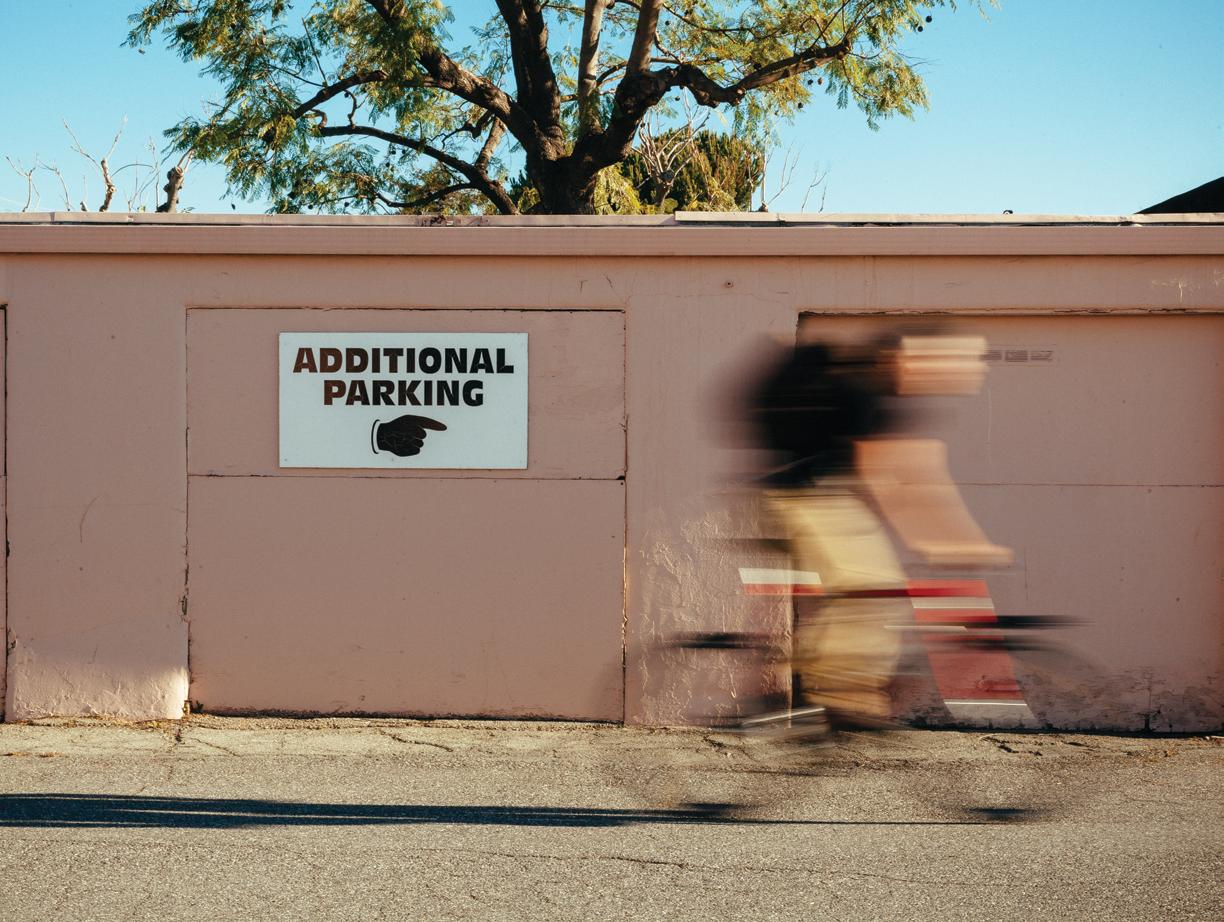
34
Why did you decide to start a bike messenger service, and why in San Jose?
San Jose has not had a proper bicycle messenger service for almost two decades. There used to be a few companies back in the ’80s, but by the time of the Tech Boom, email and fax made conventional messengers redundant.
We found it intriguing that Silicon Valley had no bike courier service of its own. With the support of our local community, and a lot of personal time and energy, we spent a year researching what it would take to launch and operate a bike courier service before opening Cowgirl Bike Courier for business this past September.
Tell me more about your mission to empower women to take part in a male-dominated industry.
According to The League of American Cyclists, 24% of bicycle rides are by women, yet over 80% of women are in approval of bike use. By putting women at the forefront, in our company title, mission statement, and logo, when it came time to hire couriers, out of the 35 applications we received, 22 of them identified as women. Through our company, and our actions, we create the change we wish to see in the world.
How many couriers do you currently employ?
We currently have eight individuals working for us as independent contractors. Each courier makes 50% commission on every delivery charge they fulfill.
Is there such a thing as a typical day in the life of a bike messenger? If so, what’s it like?
A lot of waiting, actually. We typically have scheduled deliveries between 9am and noon, which are fun because we can take our time travelling across the valley. Then, there’s generally a period of calm until 5pm, which is when our restaurant clients open for dinner and make use of our delivery services. On a good night, we’ll be going nonstop from 5:30pm to 9pm. The night hustle is what appeals to a lot of our couriers. Riding at night, navigating through traffic, all the while moving fast to ensure food deliveries stay hot.
You’ve partnered with Veggielution to deliver their CSA farm boxes. What other businesses do you have partnerships with?
We’ve been very fortunate to partner with quite a few local businesses and nonprofits. Aside from Veggielution, we’re very fond of the Silicon Valley Bicycle Coalition, and all of the work they do for cyclists in the Santa Clara and San Mateo counties.
We also work very closely with La Dolce Velo bicycle shop. They’ve been rooting for us since day one, and continue to support us through thick and thin.
What’s the interview and hiring process like to become a Cowgirl Bike Courier? Do you have any advice for aspiring bike messengers?
Oh, man. We put our first batch of couriers through interview hell. It took part in two portions, with the first being a typical interview process at Roy’s Coffee in Japantown. We had two of our friends conduct the initial interview. What the couriers didn’t know is that the interviewer would be taking notes of what their initial impression was of the individual. After this, our friends stuck the note in an envelope, addressed it to a booth at B2 in San Pedro Square Market, and sent the courier off to make a delivery.
Every applicant took off at Mach speed, in an attempt to be a fast courier. We weren’t concerned with speed. We wanted someone who could be calm and cool under pressure. Amanda and I were the ones due to receive their delivery, and of course, each applicant that showed up was dripping in sweat, completely ecstatic with the opportunity given. A third of the applicants took the note to the wrong spot and left. They were cut instantly.
When the courier made a successful delivery to us, we introduced ourselves as the owners of the company, and asked them to take a seat for the second part of the interview. Each applicant, hopped on adrenaline and endorphins, had to keep their cool while trying to convince Amanda and I that they were the right person for the job. This was to replicate the process as if they were delivering legal documents, as our clients would prove to be even more cutthroat than ourselves when it came to professionalism and dependability.
What is the weirdest delivery you’ve ever made?
Medication for a client’s pet. It’s definitely an untapped market that we’ll be looking into.
Cowgirlbikecourier.com
twitter: cbcourier
facebook: cowgirlbikecourier
instagram: cowgirlbikecourier
Cinequest:
Halfdan Hussey and Kathleen Powell, 25 years of Film Festivals Together
Interview and Photography by DANIEL GARCIA
Congratulations, 25 years working closely together. Longer than some marriages. How have you navigated this partnership?
H: The best thing is that we have similar visions and the desire to help people. We love art and creativity. What has been great is that we have carved out very different areas of ownership. We’re both very strong, driven people. So having space where we each can run our own areas has been key. And yet, we help each other out. Having things that are ours alone allows us to be great partners, and remain friends through all of this.
K: It didn’t come easy, it came over time. We figured it out, there wasn’t a book or teacher. Having the different areas has really benefited us, but just as important is that we have the same fundamental values.
We took the Cinequest staff four years ago through a process where we asked about their values, about what was important to each person, and then created a list of what we wanted people to think about. Things like: who do I want to work with, what values do I have that I want the person sitting next to me to have? From that, we developed these pillars that are key to our organization. Integrity, which is one of my top priorities. Caring for people. High energy, don’t want someone low energy or dreary. And then, world-class excellence. We’re not talking about perfection, but about having excellence, doing work we are proud of.
We all come with different backgrounds, but these fundamentals are key to us.
Do you step on each other’s toes?
H: We are both strong people, so we had to talk about who is taking the lead on different projects...
K: Choose your battles. And know what and why something is important to you. If I’m aware that Halfdan is extremely passionate about something or a direction is really important for him, then I am willing and want him to have that.
You have to see what is important and who is better at what. So you learn about it over time.Vision, getting people excited, getting volunteers and getting a staff to move in a direction, and the vision of the company—that’s all Halfdan.
H: One part I am really good at is making the vision real. I can execute. You give it to me, I’m going to make that real. Kathleen is amazing at getting the resources to make something real. All the financial components Kathleen manages. She works diligently to ensure that what we raise and earn is handled well, she oversees our stewardship of the resources. She has kept us in black every year. That’s extraordinary. If it wasn’t for Kathleen, it might be the other way. It isn’t because of me, [laugh] I am good at not spending, but Kathleen ensures all the fiscal aspects of the organization.
What have you learned from doing Cinequest?
H: A huge lesson I’ve learned from the film festival, that at first it was sort of “Kathleen’s and my Cinequest thing” that we’re giving to San Jose and the world. But after a while, I realized it was the community that made Cinequest. A community of thousands of people, people that had been there from the beginning. They are very connected to it and it matters to them. Cinequest taught me what community means and the importance of community.
I remember during the challenging years as we were building, I had lunch at Chris Esparza’s club—Fuel—and he told me, “Cinequest means so much, we look forward to this every year.” I thought, really?, I didn’t know people cared this much. It really inspired me. And it really helped me carry on, seeing that this could bring people together. And to be part of these people’s lives was rewarding. Cinequest taught me what community is.
K: When you see it happen, it becomes so special. When people change from just going out to see a movie, or going out on a date, to being a part of the community, then they feel part of the community, and they plan for it, work for it, get excited about it. Such an incredible feeling, when others feel they own it.
36
“COMMUNITY: CINEQUEST TAUGHT ME WHAT THE WORD MEANS.”
_Halfdan Hussey

Doing the “Picture the Possibilities” with youth, was it part of the original Cinequest plan?
H: A great movie can impact and transform a life—even if just for a day—like any work of art can. Art completely changed my life. So, the original idea was to pass on the experience Kathleen and I had with our independent film to other artists, giving them a chance to showcase their work and connect with audiences. It was about healing and giving back.
But dealing with youth, that wasn’t something I originally thought about. I hated being a teenager. [laughter] You’re not going to find in our original papers and vision... “we love teenagers.” [laughter] But we’re gaining opportunities for mentoring teenagers and college students. We found out a few years ago that when we shared our abilities to create and processes for creating, it would help them.
I was playing around with an idea for The Seven Powers of Creating—I shared it with the teens and people I was mentoring. I was exploring with it, since it was a process of taking a picture and making it real. But I thought it was boring them. Then I got a letter from someone who had been in a talk. He said he had been really miserable, 18 years old, overweight, drug addicted, abused, and ready to check out and commit suicide. But there was something about the Picture the Possibilities thing—he noticed that I hadn’t come from any sort of special place—and he thought maybe he could do this too. He started to work
on his health, got out of his abusive situation, and was interested in film and working in Japan. I then realized this thing that I thought was boring people is important. It was valuable to just share ways to create.
Then Kathleen and I and some partners wanted to do something global that would utilize film as one of the ways to create. We started a program to show youth how films could transform their situation. To show them, whatever challenges they might be facing, that they could utilize creativity to not only change their lives, but to create what is inside of them and what they are excited about. So we give them tools and the technology to help them have the confidence to do that. We’ve been doing that for three and a half years now. It is just as impactful as the film festival.
K: It’s hugely rewarding work that we do. It’s global, year round we can see the change in the youth we are doing the work with. It’s just as important as the work we are doing with the film festival, because if we can inspire the youth to not give up, to not settle to whatever environment they might find themselves in now, what an incredible thing.
H: The thing about teens is—it was my least favorite group of people in the world—but now it’s my favorite group. The minute I started working with teens, I fell in love with it. I didn’t have a good teenage life, and they don’t either, but people are amazing at that age. Now I have become a person who loves that age.
25 YEARS
“WE’RE NOT TALKING ABOUT PERFECTION, BUT ABOUT HAVING EXCELLENCE, DOING WORK WE ARE PROUD OF.”
38
_Kathleen Powell
What do you sense for the film industry—what’s the next change for the storytelling film industry?
K: I think a couple of things are going to happen. At this year’s Cinequest we are going to showcase new technology that’s going to change your film-going experience in the movie theater. It’s by a company called Barco Escape.
It’s where there are three screens that the filmmaker has the ability to work with. You may have your film showing on the main screen straight ahead, while on a screen to the right you might have what’s going on in that person’s mind. And maybe an expansion of that scene on the left. So now with three pallets to work with, it’s possible to tell a story in a much different way that is more than just making the screen wide, though it could be. This technology then changes the viewing experience, and will change how stories are told.
H: I sense the traditional industry that’s been holding on for years will radically change. Technology and innovation have been opening up global channels and democratized opportunities and that is growing. But we haven’t finished the job.
We haven’t seen, since the ’70s, a lot of real creativity and innovation in filmmaking. We have seen innovative technologies to make films, to get film seen on different screens from mobile to 3D. But what we haven’t seen is artists becoming more innovative in the way to tell a story, like
we had in the ’60s and ’70s, through global and American directors who really looked at innovative forms.
We haven’t seen another era of wow, like Coppola or Kurosawa. But the technology gives opportunities to new filmmakers, who will be in new form or the studio, and who will be global, with different types of movies. Different types of stories and new ways to connect with audiences. We are going to see different types of movies. Animation has been the most innovative area because you can create new worlds. But as virtual reality starts to intersect with the real world, and with technology like Kathleen mentioned with the three screens, then you begin to change the space of a film artist’s mind. Then we will see different ways of making a film or telling a story. And, even, a different story.
I just think you are going to see all of a sudden an incredible era of filmmaking. It’s not today, but it’s coming very soon.
QUEST CINEQUEST FILM FESTIVAL 25 Feb. 24 - March 8, 2015 cinequest.org twitter: cinequest
39
J E F F CHANG
CULTURAL DIALOGUE FROM A BOOM BAP IDEOLOGUE
Written by Brandon Roos
Jeff Chang may be one of today’s leading contemporary cultural scholars, but there are plenty of signs that he’s still very much a fan of the culture he writes about so eloquently and thoroughly.
Inside his office at Stanford’s School for Diversity in the Arts, filled with family photographs, an overstocked bookshelf overflowing onto the floor, and playful notes from students, he joyfully tells of how hip-hop has become a cultural bridge for him to connect with his children.
Periodically, he’ll go through massive trading sessions with his two sons, aged 18 and 13. In exchange for schooling them on old school hip-hop and soul, he gets to find out about emerging acts like Makonnen, Bobby Schmurda, and Father. Such examples of art breaking down barriers and changing minds has been a critical narrative through-line throughout Chang’s illustrious career, in which he has penned two books, edited a hiphop anthology, and contributed to such storied publications as The New York Times, the Guardian, The San Francisco Examiner, URB, and The Village Voice
Though he’s been writing about hip-hop since the ’80s, Chang exploded onto the landscape with Can’t Stop Won’t Stop in 2005. With its exhaustive research and accessible, anecdotal storytelling, the book emerged as
a seminal case study on hip-hop, helping cement the oft-maligned culture as a culturally rich domestic movement. The book won both the American Book Award and the Asian American Literary Award.
The son of working class parents, Chang grew up in Honolulu, Hawaii and attended the ‘Iolani School, one of the state’s most prominent private prep schools. He attended on scholarship, which involved him serving and cleaning up after his peers, an experience he says was his “introduction to class issues.”
Raised in a family with Hawaiian ties that traced back several generations, Chang grew up with a pretty open notion of race.
“It was natural for me to be around people who were literally my blood, but who were much darker skinned or lighter skinned than I was,” he recalls. “The whole Benetton [concept of] all the colors of the world in the spectrum intermarrying with every single race—that was my family.”
It was a bit of a culture shock, then, for Chang when he arrived on campus at UC Berkeley in 1985. He remembers being called chink and told to go back to where he came from within a month of his move to the Bay Area, a shocking revelation for those who view the region as a
40
Since leaving his native Hawaii for UC Berkeley in 1985, writer and scholar Jeff Chang has emerged as a potent contemporary cultural critic and one of hip-hop’s leading advocates.
Photography by daniel Garcia

beacon of social progress. As Chang notes, his freshman class was the first at Berkeley to be majority non-white, so he saw the Bay Area’s cultural progress manifest itself before his eyes.
It was around this time that he started writing for different publications in hip-hop’s emerging zine scene. “I found that it was a really good place to be able to capture a lot of the things that I was feeling about hip-hop, race, and culture at the time,” he says. That experience was rounded out by a stint spinning hip-hop at Cal’s radio station KALX.
Chang graduated with a degree in economics to please his parents. However, classes taught by Ronald Takaki— characterized as a superhero by Chang and his classmates—were crucial to his development as a burgeoning activist.
Upon graduation, he ended up in Sacramento working in state legislature from 1989 to 1992. He kept his love for hip-hop alive by scoring a spot on-air at UC Davis’s KDVS. During this time, he played a part in helping form the Solesides collective (now known as Quannum Projects), comprised of hip-hop luminaries DJ Shadow, Latyrx, and Blackalicious.
Five years their elder, Chang remembers Lyrics Born (one half of Latyrx) as the guy who won all the contests. DJ Shadow was the encyclopedic music nerd who made all the requests. “I was the ideologue, if anything,” says Chang of his place in the collective. Reluctant to take credit for forming the crew, he insists Solesides would’ve happened anyway—he just made the suggestion at the right time.
Chang left for UCLA, where he studied Asian American Studies, in the summer of 1992. He continued pushing Solesides, acting as the crew’s de facto manager when they pushed out their first release in 1993. Over 20 years later, he’s proud to have contributed to something that’s ensured fruitful, lasting careers for his close friends.
Despite his accolades, when he recounts his six-year process for writing Can’t Stop Won’t Stop, Chang admits, “I’m a late bloomer as a writer.” Though the book wasn’t released until he was almost 40, it had a sweeping impact. His prose thoroughly contextualized hip-hop’s cultural explosion in the Bronx in the ’70s as an empowering cultural response to the rampant poverty and violence present in the borough at the time. A decade after its release, Can’t Stop Won’t Stop stands as a defining statement on hip-hop culture.
Around 2009 or 2010, Chang was approached by Sami Alim, Faculty Director for Stanford’s Institute for Diversity in the Arts (IDA). A hip-hop head, Alim informed Chang that he had an opportunity for him to use hip-hop as a lens to explore notions of diversity and social change in the arts. Stanford provided Chang with a chance to once again work directly with students.
Chang maintains that IDA’s hip-hop studies program is among the best in the country, adding “We’re getting to do research that is cutting edge and that has the possibility to change the way a lot of people think about arts education.”
While touring Can’t Stop Won’t Stop, Chang stumbled upon the idea that eventually became Who We Be, released this past October. At one event, he was part of a panel that looked to contextualize hip-hop within the multiculturalism movement. It was there he realized the topic was rich enough to cover in a book. The only problem was that his editor didn’t bite, saying no one was interested in multiculturalism at the time.
He abandoned the idea until 2008, when Barack Obama’s presidential campaign provided the flash point he needed. As Chang began to ask, if we were really past race—if multiculturalism helped us overcome inequality—why was Obama’s campaign proving so divisive?
“Multiculturalism taught us what we can’t say to each other in civil company,” explains Chang, “but what it hasn’t taught us is the conversation that we need to have to move beyond just being civil to each other and to really treat each other as equals.”
Who We Be has proven incredibly timely given the recent fervor surrounding the deaths of Mike Brown and Eric Garner, black men killed by white police officers. He feels both examples display the split-second implicit bias that still exists underneath our notions of living in a post-racial society, and it’s an idea he explores in the book.
“Noticing difference isn’t in and of itself a bad thing. Although many people want to demonize that as such, what I think happens is that difference gets attached to notions of what’s superior and what’s inferior, who belongs and who doesn’t belong,” he says. “Who We Be as a book is about two things. On the one hand, it’s a celebration of the way that artists can change the way we literally see each other and [can help us] see the world for the better. But on the other hand, it’s asking some hard questions. After multiculturalism, after hip-hop, after
42
“It was natural for me to be around people who were literally my blood, but who were much darker skinned or lighter skinned than I was. The whole Benetton [concept of] all the colors of the world in the spectrum intermarrying with every single race—that was my family.”
“Multiculturalism taught us what we can’t say to each other in civil company, but what it hasn’t taught us is the conversation we need to have to move beyond just being civil to each other and to really treat each other as equals.”
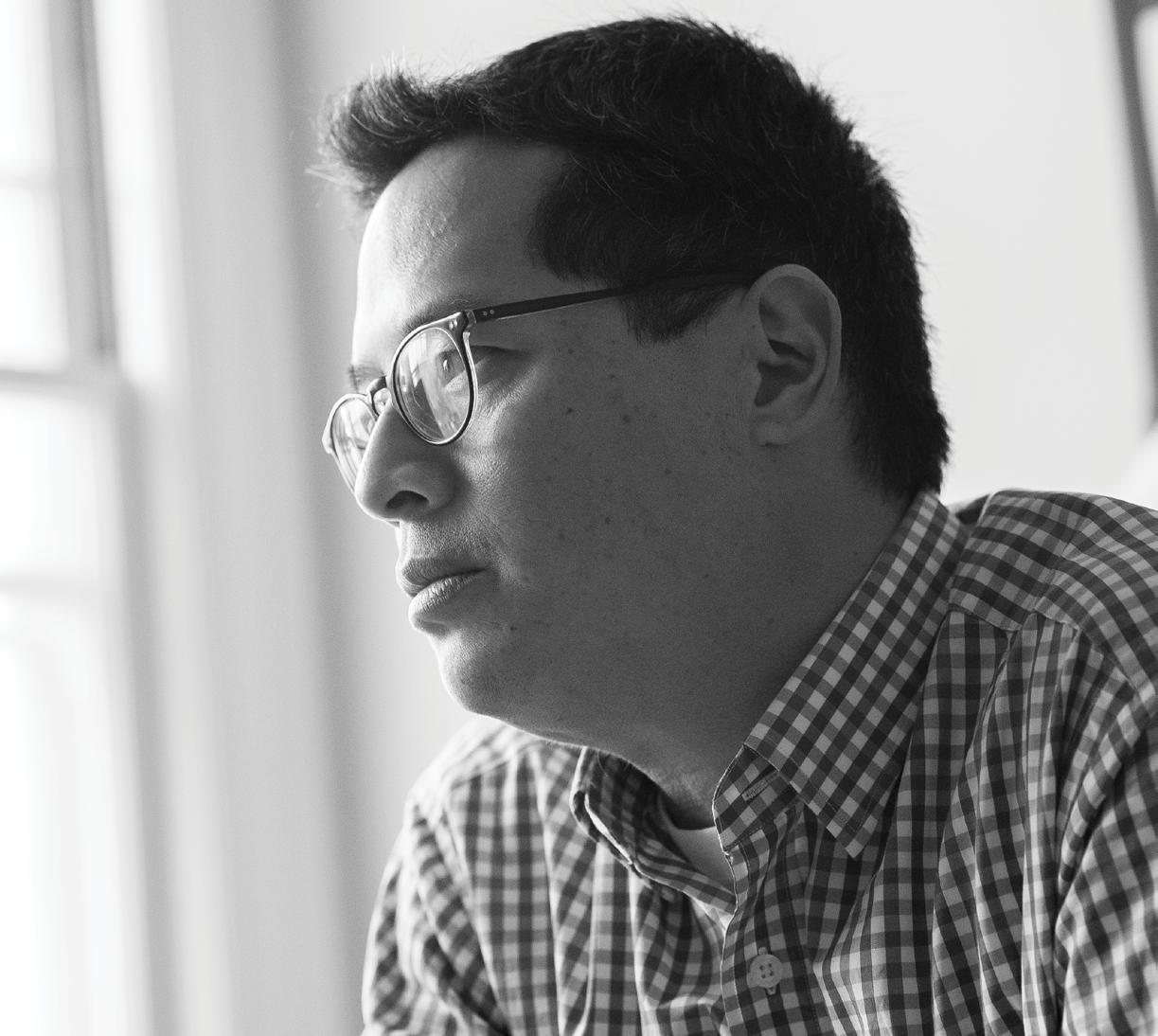
43

all of this cultural desegregation, why do we still have rising rates of inequality and cultural resegregation?”
Exploring these ideas of social justice always seemed to run counter to his moonlighting as a DJ and hip-hop writer. Only recently has he discovered that these were simply two parts to the same mission.
“I started out as an activist interested in helping to further social change and social justice. At the same time, I was a DJ. I took for granted that I was engaged in something that had already changed my mind millions of times over. After I’d been writing about hip-hop for years, I realized, ‘Wait a minute, all this is part of the same spectrum.’”
Though Who We Be only recently hit shelves, Chang already has his next two projects lined up. Youth will explore many layers of being young. He’s also starting to work on a Bruce Lee biography.

“What’s cool for me is I get to disseminate hip-hop to folks who are at the age I was when all these things were in the air for me,” he says.
Chang’s role at Stanford speaks to the lasting impact hip-hop has had on the global consciousness, not to mention his role in helping redefine the movement’s cultural significance. The chance is not lost on Chang, who recognizes his unique opportunity to spread the message of hip-hop’s power and relevance to a room full of bright young minds at one of the most prestigious universities in the world.
Not a bad backup plan for a cat with an econ degree.
jeffchang.net
45
FRANCO FASHIONING A NEW FUTURE
Franco Uomo is outfitting Silicon Valley in elegance and style.
Franco Uomo looks like a character right out of a Fellini film. He wears a sleek, dark suit—his shirt is a Mediterranean blue with thin stripes of rusty oranges and iridescent greens. His skin is smooth and olive; his dark, thick hair is combed back with glowing pomade. He could be in a convertible speeding along a noisy Roman street, with a haughty blonde in the passenger seat. Instead, Franco is a humble Santana Row store owner, but one who is single-handedly changing the way Northern Californians shop.
At a Franco Uomo store, all shirt sleeves are always hemmed. Every button, thread, and inner lining is carefully chosen. Very few customers leave the store with a garment bought straight off a shelf. Franco tells us to look at a collar, his finger gently following the smooth line. We are told to notice how it spreads. “The typical Silicon Valley guy has a grey shirt,” he says smiling. “But I tell them to add pink stitching and yellow buttons for charisma. I tell them ‘Yes! Add some cufflinks even if you are wearing jeans on a Friday.’ I want them getting compliments.”
Ties and bow ties are handmade in London. Each fabric is individually approved; many are shipped from Turkey and Italy. Franco, along with his friend and colleague Angelina Haole, has brought back what Angelina calls an “endangered” concept: the men’s store. Franco visualizes, while Angelina is the technical half. Franco and his team are sculptors—they will choose what to add and what to chip away—until an exquisite and timeless piece remains. They are the suit Michelangelos of Northern California. Their primary focus is bespoke, under the Anwar Collection, named after Franco’s Afghan birth name. They also offer made-to-measure services.
Unlike a debonair Fellini male lead, Franco himself is not aloof or untouchable. He is genuinely curious about the people who admire his brand. “People tell him about their lives,” Angelina says. “And ten years later they come in and he still remembers details of their conversation.”
The world of Franco Uomo is one that you would expect to exist either only for the affluent or in a small village from another century. Perhaps you have seen something like it in a film, never thinking you could experience it for yourself. “There are no limits,” Angelina says with a smile, her eyes twinkling. “We’ll custom-make shoes. We can have fabric woven for you.” Franco interjects excitedly, “You see the pinstripe? I can have your father’s name in tiny letters be that stripe.” These are pieces Franco hopes you will pass down to your children.
Does the average Bay Area man or woman have a need for this? Many startup folks wear flip-flops and jeans to work. Franco is quick to clarify: “Those in technology have the appetite for something artisan. They, like us, are artists, too. Those who we think don’t have an appetite for this, are actually the driving force behind it.”
The idea is to have something no one else has. It is Franco’s visionary talent that sets him apart. “I will feel my way through to the result, Franco just visualizes it,” Angelina explains.
Franco and Angelina argue over a tie’s color. They place fabrics, shirts, and buttons on a table. They take a step back and stare, index fingers on chins, brows furrowed. An idea sparks. They quickly grab a piece of fabric and place it down. They study it again. You are Franco and Angelina’s muse; your ideas are the inspiration for their shared vision. But this is no movie or make-believe—this is how the business is run. The interaction between Franco Uomo and his customers, and his hands-on approach to dressing, set him apart. He does not believe clothes make the man (or woman). You have to wear the garment. It should never wear you. That would be against Franco and Angelina’s sartorial religion.
“It is not what you like, it is how you look,” he firmly states. “To us, clothing is a representation of your best self. We dress you in the best possible scenario for you.
46
Written by Anna Bagirov Photography by Daniel Garcia

“To us clothing is a representation of your best self. We dress you in the best possible scenario for you.”


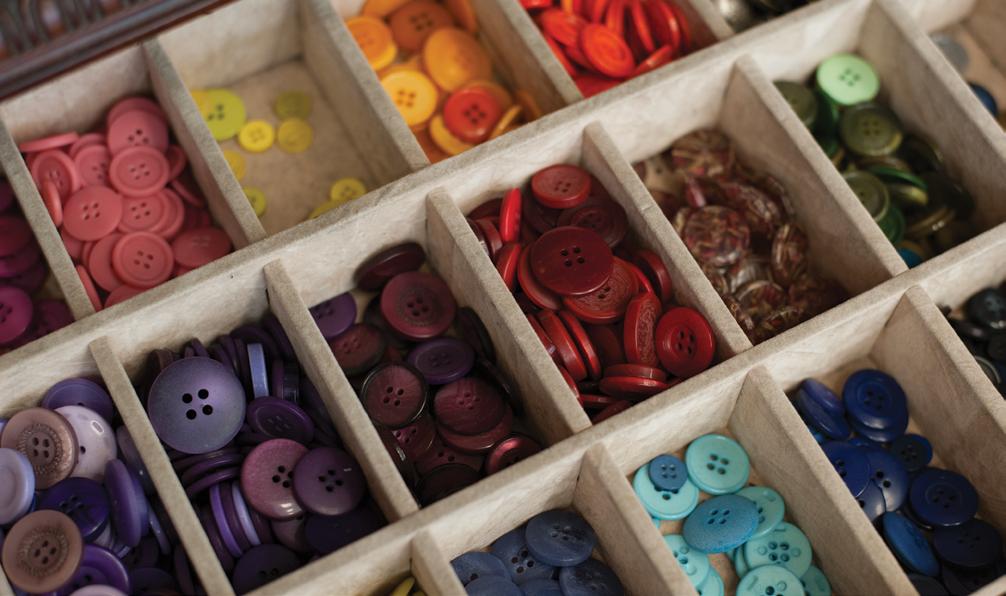
We don’t ask people what they like.” But Franco is no know-it-all. He is a student as much as he is a master. “I am a book of many pages,” he reflects. “I have met about 200,000 people in this business. I took every experience and adopted it. I add new pages every day.”
The story of Franco Uomo dates back to his birthplace of Afghanistan. When he was five years old, his father took him to have his first suit made, and the romance with fashion began. The ugliness of Russia’s war with Afghanistan cemented his appreciation for the elegant, the beautiful, the positive.
He was the last of his brothers to emigrate, and so Franco considers himself an underdog. For 14 years, he worked in a suit store. Today, Franco Uomo is the official designer for the San Jose Earthquakes. He and his team have designed for countless 49ers, Sharks athletes, and NBA players. Uomo dresses technology workers at every level, but is well known for dressing top-level executives and the founders of companies such as Apple, Google, and Facebook.

In 2006, their Valley Fair location opened. In 2009, they opened the doors to their second location, in Santana Row. “If something did not work out as planned, I think: ‘It’s good that it happened this way.’ God had a better plan for me. I can convert bad news into good news.” His voracious appetite for fashion is closely aligned with his emphasis on healthy mental living. The negative is another positive. He believes attitude, not talent, drives progress, and clothes complete the circle. “Good clothing makes our energy better,” Franco says matter-of-factly.
Franco resists any talk of goals or a business plan for the future. He looks to his customers, and his inspiration from both natural and manmade beauty, to drive his actions. “I want to elevate to other people. We expand our business by our inspiration, and much of our inspiration is from our customer.”
Franco embraces the fact that his business’s path can change by the day. He is, however, certain of one thing. It does not matter if you do not wear a suit to work or rarely go out for a fancy dinner. He will find a way to place you in that sumptuous Fellini scene. Why not be that smooth, coiffed, chic version of yourself? You may be behind a computer, at a lunch with friends, or at a business meeting, but to Franco, that doesn’t mean you can’t have a bit of elegance in your everyday life. The fantasy does not have to be unattainable. For Franco, it is real. And he is ready to tailor it, stitch-by-stitch, to you.
49
francouomo.com Santana Row 3055 Olin Ave. Ste. 2100 San Jose, CA 95128 408.260.9868 Valley Fair 2855 Stevens Creek Blvd. Santa Clara, CA 95050 408.247.2121
Poncho - Simonetta, Black Cat Hats Los Gatos $58
Pants - Citizens of Humanity, Rouge Los Gatos $245
Black Scarf - Look, Prim Los Gatos $24.50
Grey Scarf - BP, Nordstrom Valley Fair $24
Shoes - Saint & Libertine, Kash Santana Row $310
Throw - Ugg Home, Nordstrom Valley Fair $295
BI KE SH OP
Photography: John Agcaoili
Photo Assistant: Rogelio Barrera
Production Assistant: Nathan Brasil

Model: Sarah, JE Models
Hair: James Hoang for Bedlam Beauty and Barber
Make-Up: Ivadell for DSOTM
Producer/Stylist: Kristen Pfund
Style Assistant: Victoria Felicity Elizondo
Production Company: DSOTM Location: Raber’s Parts Mart
Jacket - Lotus, Los Gatos
Pants - Articles of Society, Prim, Los
 $110
Top - Olivaceous, Prim, Los Gatos $58.50
Gatos $98.50
Necklace - Lotus, Los Gatos $76
Swirl Silver Ring - Karine Sultan, Black Cat Hats, Los Gatos $25
Cross Ring - Flying Lizard, Santana Row $67.50
$110
Top - Olivaceous, Prim, Los Gatos $58.50
Gatos $98.50
Necklace - Lotus, Los Gatos $76
Swirl Silver Ring - Karine Sultan, Black Cat Hats, Los Gatos $25
Cross Ring - Flying Lizard, Santana Row $67.50
 Top - Lotus, Los Gatos $46
Pants - Nikibiki, Lotus, Los Gatos $38
Ring Set - Lotus, Los Gatos $36
Earrings - Anna Sukardi, Blū Cielo, Palo Alto $50
Top - Lotus, Los Gatos $46
Pants - Nikibiki, Lotus, Los Gatos $38
Ring Set - Lotus, Los Gatos $36
Earrings - Anna Sukardi, Blū Cielo, Palo Alto $50
 Jacket - Line, Rouge, Los Gatos $621
Skirt - Lotus, Los Gatos $42
Earrings - Flying Lizard, Santana Row $60
Jacket - Line, Rouge, Los Gatos $621
Skirt - Lotus, Los Gatos $42
Earrings - Flying Lizard, Santana Row $60
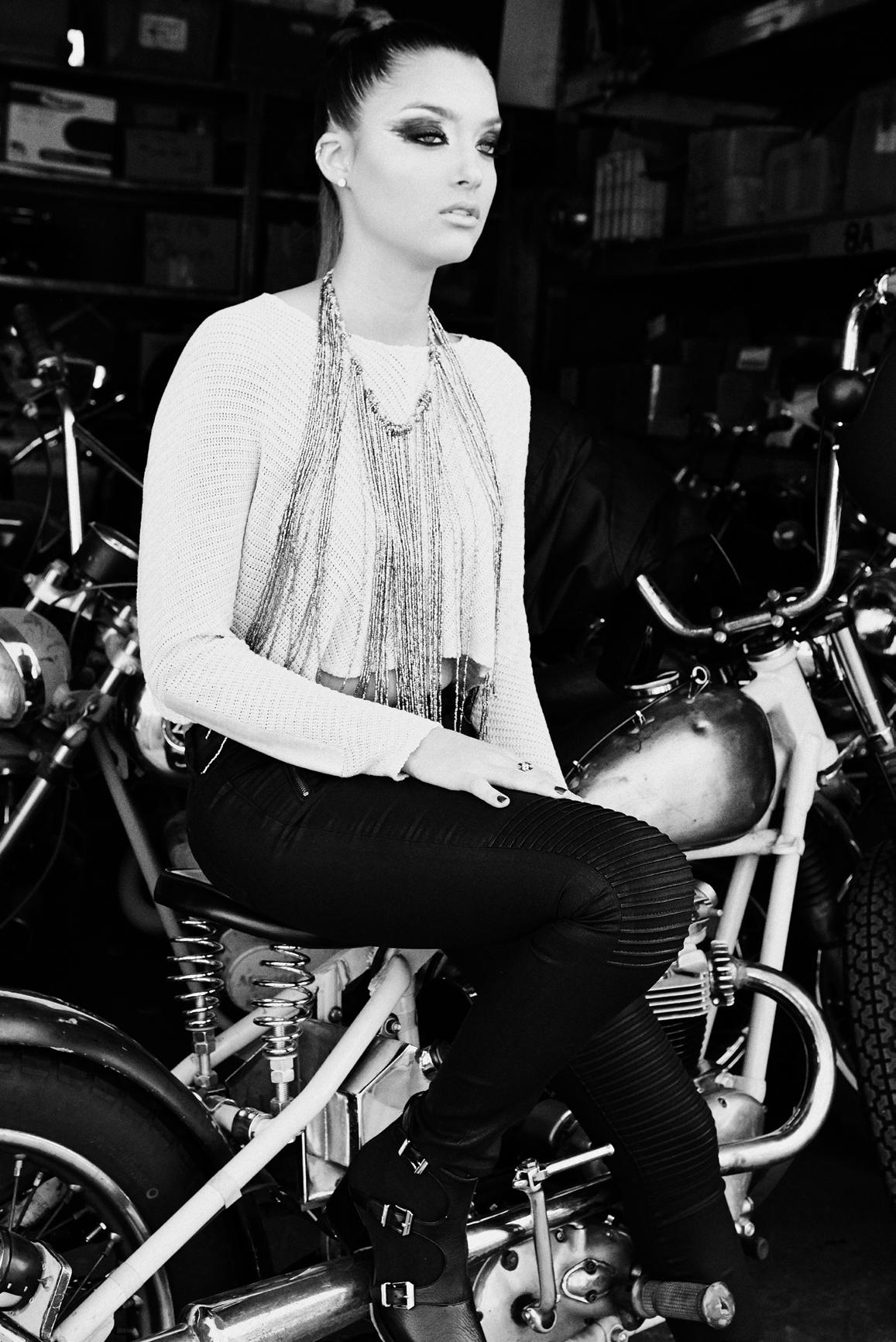 Top - Olivaceous, Prim, Los Gatos $58.50 Pants - Articles of Society, Prim, Los Gatos $98.50
Shoes - Donald J Pliner $575
Necklace - Lotus, Los Gatos $76
Cross Ring - Flying Lizard, Santana Row $67.50
Top - Olivaceous, Prim, Los Gatos $58.50 Pants - Articles of Society, Prim, Los Gatos $98.50
Shoes - Donald J Pliner $575
Necklace - Lotus, Los Gatos $76
Cross Ring - Flying Lizard, Santana Row $67.50
 Romper - Charlie Jade, Lotus, Los Gatos $266 Earrings - Anna Sukardi, Blū Cielo, Palo Alto $75
Romper - Charlie Jade, Lotus, Los Gatos $266 Earrings - Anna Sukardi, Blū Cielo, Palo Alto $75
OH, HONEY, HONEY
THE NEXT BIG THING IN BEER ISN’T BEER AT ALL

IF YOU THINK MEAD IS A THING OF THE PAST, THINK AGAIN.
Written by Anna Bagirov Photography by Gregory cortez
Michael Faul is one of the country’s select few winemakers to be shaping the next pivotal trend in America’s thriving craft beer scene. Winemaker? You read that right. For the last twenty years, Faul has been pouring and selling awardwinning mead (technically a honey wine), cider (technically an apple wine), and braggot (a honey ale).
Faul is the owner of Red Branch Cider Company and Rabbit’s Foot Meadery, and all of his products contain honey. People are often dumbfounded to find that mead still exists,
the term itself conjuring up hornedhat Vikings, seated in their long houses, toasting each other. Mead is obsolete, people think, and cider is second to beer.
Faul is here to prove that this is not so, and to mark his place in today’s mead and cider renaissance. But he started long ago. Rabbit’s Foot Meadery began in 1995. “I have the the oldest mead, Mead of Poetry, commercially available in the US, if not the world. No one has been in business that long,” he explained.
When Faul first began using apple juice, which produced a cyser, few understood the term. He soon adopted a more familiar name: Hard Apple Honey Cider. “I always kind of have a target, but I modify. I want to be fluid enough to make changes.”
Red Branch Cider Company was born in 2000, its name and emblem hailing from Celtic mythology, and it has grown every year since. Faul began experimenting with different fruit purees. Today his best selling product is the Hard Black Cherry Cider, a refreshing, delicious drink
56
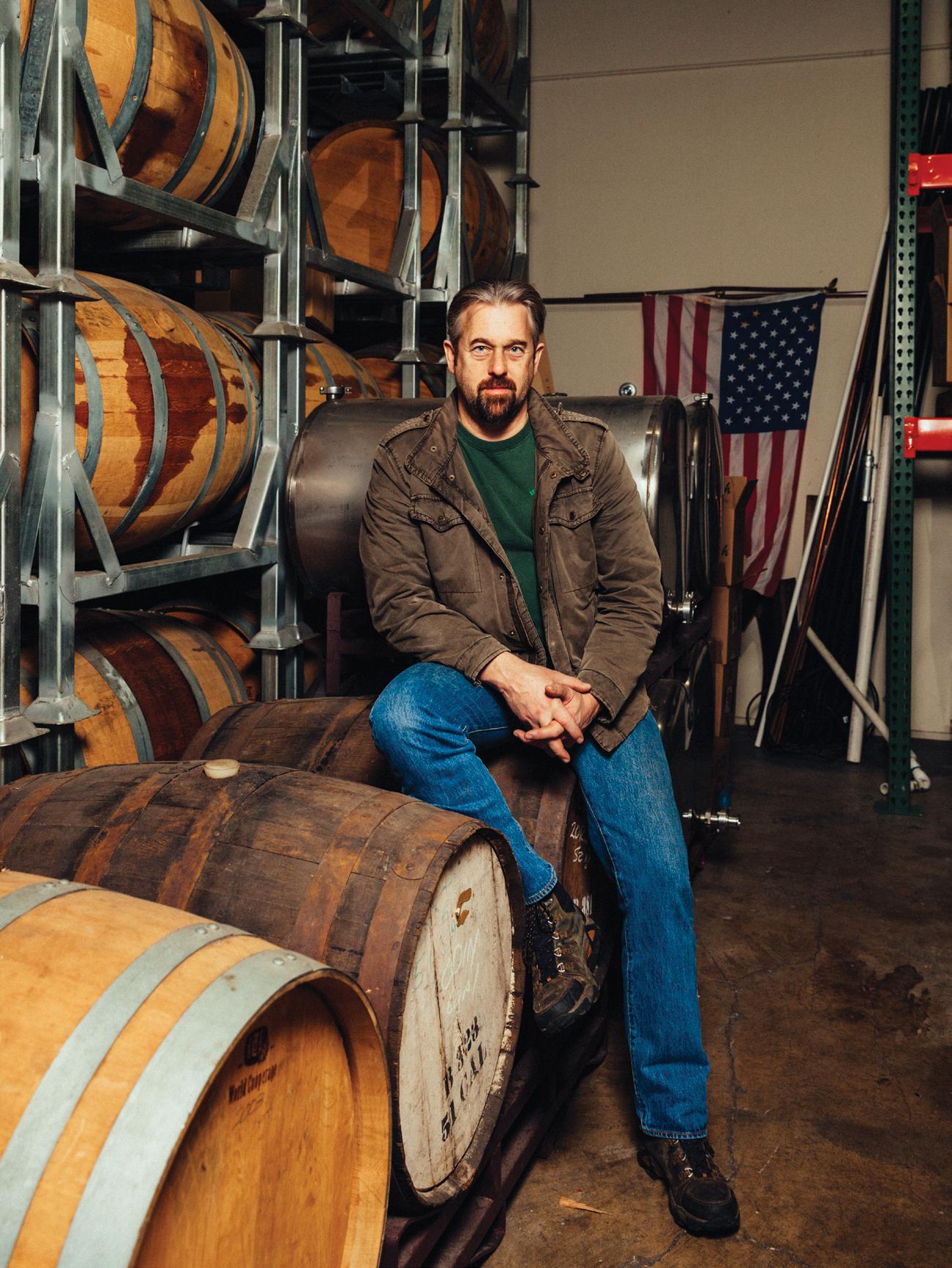
with a loyal following. Pear, pomegranate, and peach are some of the seasonal ciders. “We are unique in how we process our product. I buy apple juice from different vendors in California and Washington state,” he explains. “I have test trees now. I plan to expand to 2,000 trees, so I can plant specific varieties. I want to make the cider even better.” Faul does not believe in following a straight line. However it curves and forks, he believes it will lead him to the ultimate plan.
The cozy burgundy-colored tasting room came about in much the same way. “It was not designed; it was all very organic,” Faul reminisced. The room is as bustling, as full of energy, and as sweet-smelling as any medieval mead hall of the imagination. Memorabilia and world currency are tacked from floor to ceiling. The Tasting Room’s Mug Club has had fans camped overnight outside in hopes of gaining membership.
There are eighteen beverages to try, all brewed and bottled by Faul’s state-of-the-art equipment. “There is something here for everybody. This place brings people together in a way that nothing else does.” No doubt Beowulf and his brave warriors would agree.


58
“I HAVE THE THE OLDEST MEAD, MEAD OF POETRY, COMMERCIALLY AVAILABLE IN THE US, IF NOT THE WORLD. NO ONE HAS BEEN IN BUSINESS THAT LONG.”
“PEOPLE ARE OFTEN DUMBFOUNDED TO FIND THAT MEAD STILL EXISTS, THE TERM ITSELF CONJURING UP HORNED-HAT VIKINGS, SEATED IN THEIR LONG HOUSES, TOASTING EACH OTHER.”
redbranchcider.com

rabbitsfootmeadery.com
mfaul@redbranchcider.com
social media: redbranchcider
59
Only craft beer from California is served, with twelve varieties on draft at all times, rotated seasonally.

60
Dry Creek Grill Local, grilled, and gourmet
Written by Michelle Runde
Looking for a restaurant that serves gourmet burgers, premium steaks, slow-smoked BBQ, amazing seafood, organic salads? Look no further than Dry Creek Grill, in Willow Glen. With fire pits blazing outside and a bustling open kitchen inside, Dry Creek Grill is intimate, exquisite, and quintessentially Californian. Owners Holly and John Smith had a vision for an upscale, laid-back steakhouse, the kind they’d like to dine in themselves and, in 2012, they brought that vision to life.
The Smiths have been in the pizza business ever since turning a franchise pizzeria into their very own restaurant, Tomato Thyme, in 2003. This casual pizza spot took off, thanks to the support of the local community. “Willow Glen has been amazing to us, it’s like family here,” says Holly. “Tomato Thyme is family-oriented, sports on big TV and crayons on the table. We wanted to add a place that catered to a more adult crowd.
And we thought Willow Glen needed a nicer place to eat.” The building Dry Creek Grill occupies is the historic Moose Lodge No. 1811, built in 1965. When the space became available, Holly and John knew they had the perfect location for their next project.
The centerpiece of Dry Creek is the bar, boasting a redwood-top counter that stretches 40 feet long, all from a single tree that fell naturally in the Santa Cruz Mountains. The Smiths had always admired natural wood furniture, so the redwood was a perfect fit. The selection of drinks too fit with the grill’s cuisine and patrons. Only craft beer from California is served, with twelve varieties on draft at all times, rotated seasonally. The wine is all Californian as well, with eight whites and eight reds available on tap: the wine goes straight from barrel to glass, which prevents oxidation and evaporation, keeping it fresher than bottled wine.
 Photography by Daniel Garcia
Photography by Daniel Garcia
61
Food images provided by Dry creek grill

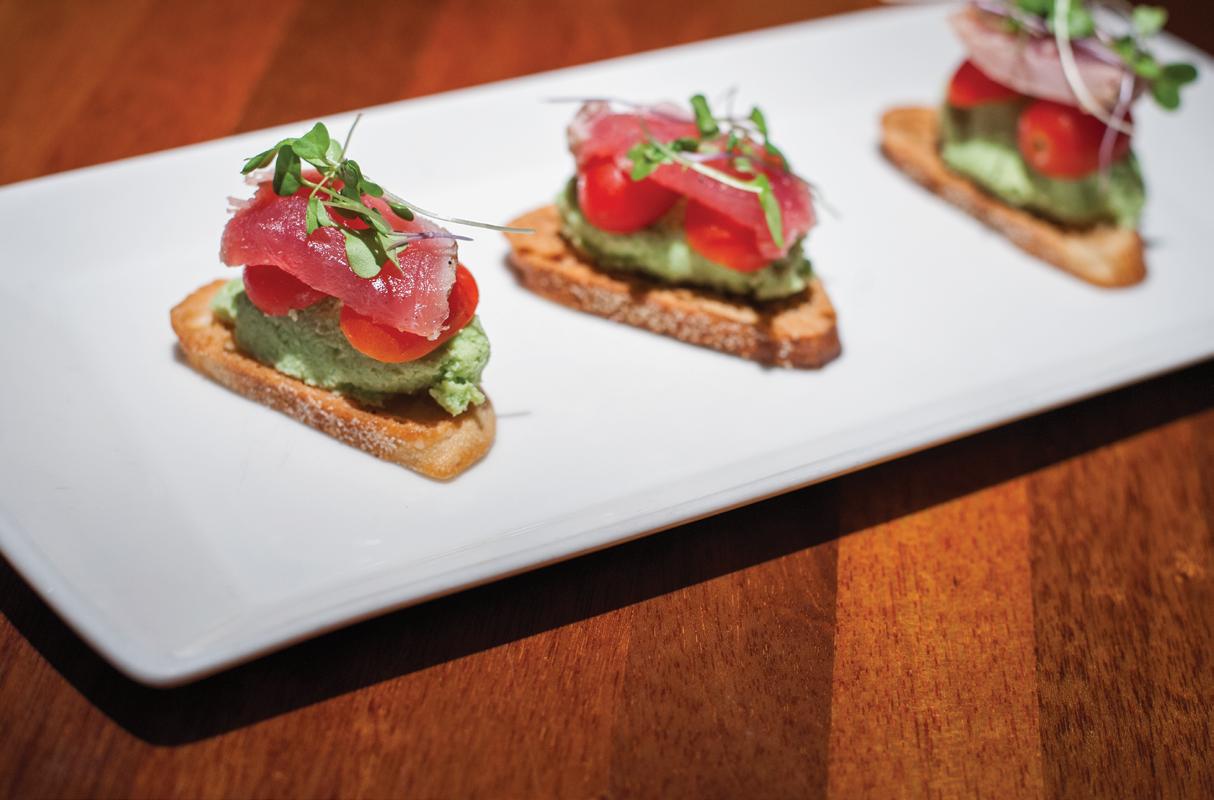
What’s on the plate is as local as what accompanies it. Everything is sourced as locally as possible, with very few items acquired from outside California. “We’re in the salad bowl of America, it’s all right here,” says Holly.
And it all is. The ahi tuna with forbidden rice is not to be missed, nor is the lamb burger: the meat is ground in-house and the buns are baked from scratch. Whether it’s date night, a business dinner, or just a drink with friends, Dry Creek Grill is the place to be.




drycreekgrill.com 1580 Hamilton Ave San Jose, CA 95125 408.264.2011
social media: drycreekgrill
63
The Trims
MUSIC FOR THE BODY, HEART, AND SOUL
Written by Anna Bagirov Photography by Gregory Cortez
You close your eyes, swept away by addictive guitar riffs, energetic beats, intense longing. You begin to dance. There is joy and pain. The Trims’ sound is a trance, carrying you along on waves of emotion. There is an eruption of hot pink light. Neon green lasers slice through the air, haloing the silhouettes of the three musicians. Fog curls around instruments. Gabriel Maciel’s voice can be deep and solid, reminiscent of Joy Division’s Ian Curtis, or it can be soprano and majestic, like Bono’s. Bryan Aguirre’s guitar and Billy Brady’s drums start out slow. The sound builds and ruptures and shivers in supersonic tones. Women are screaming. Heads are bobbing. The haunting lyrics draw you in deeper and deeper, like a tightening fist.
“We want to move you physically, as well as emotionally. It’s like the metaphor of the girl who is crying and dancing. We want to bring the arena show to the club,” Bryan Aguirre says. When playing their first show in 2010, Gabriel Maciel, Bryan Aguirre, and Billy Brady had two goals: to the play the kind of music they themselves were not hearing, and to be the band people thought of when they thought of San Jose.
The band’s name comes from their songwriting style, a commitment to trim a song to it is purest, most powerful core. “When we first booked shows,” Billy Brady remembers, “there was no one with this sound.” However, a loyal following developed and buzz in the Bay Area spread. After winning the 2011 Shot To Rock Local Band Competition, they were on Live 105’s radar, which meant opening that year’s Big Frickin’ Day concert.
It has not been luck, the recognition that has followed, but the result of “hard work, passion, and being nice.” For four years, The Trims played small clubs. “We wanted to be the band that people believe in,” Bryan Aguirre says. They credit local venues for supporting them and also the blossoming local music scene in San Jose. “It was a big deal for us to sell out the Blank Club, such a well-known venue,“ Bill Brady adds. The grind paid off when Live 105 handpicked The Trims to be the local band to open
for December 2014’s Not So Silent Night pre-party. “We were not the headliners, but got so much love,” Bill Brady remembers.
In addition to releasing a full-length album, We Cried for Fun, The Trims have topped Live 105’s Top 12 Bay Area Bands chart, and played BFD three times now. They’ve been on the cover of Metro and El Observador, their track “Out of Control” was recently featured on MTV’s The Real World, and they’ll be playing at BottleRock Napa Valley this coming May. “How many Indie rock bands are new wave, yet modern? We were a local band, the only local band, playing before two big British bands at Not So Silent Night’s pre-party,” Bryan Aguirre says. “We are Latinos from San Jose, and yet we are a California band playing British post-punk. We are unique.”
Fiercely proud of their Latino heritage, The Trims have released a Spanish track, “Vida.” Music from two cultures helped to shape their unmistakable sound. “My family was born in Mexico,” Bryan Aguirre reminisces. “They were listening to Mexican music and The Cars. My Americanborn family was listening to Morrissey and Depeche Mode.” Gabriel also grew up multicultural and bilingual. “We listened to romantic Spanish ballads and American and English bands,” he says. Today, they gather inspiration from modern dance/rock bands like The Killers, Bravery, The Strokes, and Interpol, who have incorporated deep emotional wounds within bouncy, fiery rhythms. “Our lyrics can be quite sad, the beat can very so upbeat,” Bryan Aguirre observes. “We are confident enough to know that if we play long enough, we will make it.”
They make it a point to stand firm in something else. “We wave the San Jose flag,” Billy Brady says. “We don’t know of many bands who do that. No matter what length we go, no matter what stage we are on, we are The Trims from San Jose.” Whether a Trims song is pulling you to the dance floor or moving you to tears, it is impossible not to be entranced by the energy, the sound, the fun. The pain never felt so good.
64
“We are Latinos from San Jose, and yet we are a California band playing British post-punk. We are unique.”
thetrims.net
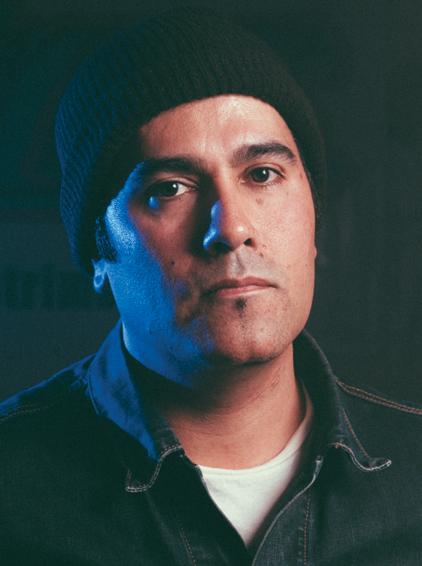


facebook: TheTrimsSJ
instagram: TheTrimsBand
twitter: thetrims

65
dj shea butter dj shea butter
SAVED BY THE BEAT
Written by Isara Krieger Photography by Jay Aguilar
DJ Shea Butter is known throughout the South Bay for his eclectic genre-defying beats, whose style demonstrates influences from his parents’ Afro-Cuban and Irish heritages. He hosts and spins at a local Motown Monday gig and has recently opened for some big-name performers in the area.
Perhaps less known to his audience is the story of Shea Modiri: how spinning records helped him overcome a rough start and how it’s led him to a smoother path. Now a role model for those unsure what to pursue, Shea’s story is a lesson in pursuing your passions—and persevering.
“When I was 18 I got into trouble with the law,” Shea laughs. His voice is honest. “Probably up until I was 22 I was going through that whole system. I had no direction. When you take that kind of chuck out of a young person’s life, you feel kind of stranded. Music was always part of the coping process.
I remember my first time going into a music store and picking up a record. The 12-inch discs always came with remixes. Now records are coming back in style, but back then they were normal.”
“I started picking up a record every weekend. I had no friends, a crappy

job, a crappy relationship,” He laughs again. “I was just [buying records] for pleasure. Then my record collection was building itself and I started meeting people, and I was faced with a lifechanging turn, and it was like—what the hell do you want to do with your life?”
At this point, Shea enrolled in San Jose State’s Radio program. “I figured going back to school was a good way to kill two birds with one stone. It turns out radio wasn’t for me, but I got my start DJ’ing in front of people.”
“It was just me and my cat in my garage, trying to learn, trying to figure it out.
66
“HIP HOP DEFINITELY SAVED MY LIFE.”
“HIP HOP DEFINITELY SAVED MY LIFE.”
“Then by law of attraction, or fate, I met some really influential people who have sparked the last four or five years of professional DJ’ing, or attempting it, with some part-time jobs mixed in here and there. They gave me an audience that I otherwise wouldn’t have had. I came into [DJ’ing] late. Everyone has been doing this since they were teenagers in high school. I would’ve saved a lot of trouble if this were so for me.
“I’m one of those stories…” Shea laughs again, “Hip Hop definitely saved my life. It got me on a good path and has been very influential.”
“Life’s a struggle. It’s not always easy, and nothing is consistent which is interesting. [With this work] there’s no health insurance, no vacation or anything like that, but at the end of the day I do what I love.”
“When you know yourself, you do well. I could go to a big gig and get paid a lot of money, but if my heart’s not in it, it’s not worth it. What’s best is a $100 gig I’m totally invested in.”
When asked about his favorite shows to play, Shea responds, “I like doing new gigs. I still get nervous before any gig, I like that feeling. I like a challenge. Once you get over that feeling it’s like, what’s the point?
“I want to continue what I’m doing at a bigger level. My age will probably catch up with me eventually. But there’s music supervision; there’s other stuff to do. Right now I’m in a great spot. I haven’t had to sell my soul to the devil. I’m holding out on that as long as I can.” He laughs. “I’m not in it for the Ferraris or the Champagne. Although that’s nice, everything comes at a price.”

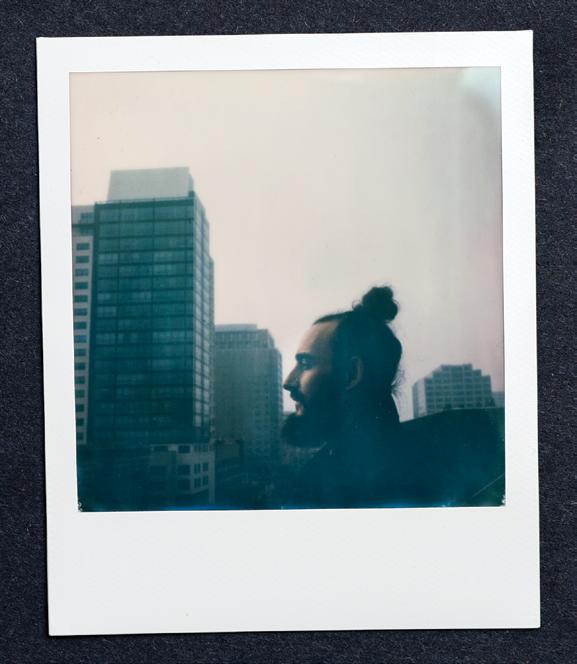
“I’m grateful to have a supportive family and really good friends that keep my head above water. A lot is networking, being around good people. But you have to believe in yourself. You always hear, ‘Do what you love.’ But sometimes the people who give you that advice already have millions of dollars. It’s not just that, you’re going to have to sacrifice. You have to live in the real world as well. I hope that comes across in my music.”
“I try not to give advice,” Shea offers. “I try to just be an example. Usually people that give it don’t follow it themselves.” Sure there’s some truth to this statement, but it seems DJ Shea Butter’s might just be one of its exceptions.
DJsheabutter.com
twitter: djsheabutter
facebook: deejayshaybutter
67
CATHLEEN MILLER TAKING TIME TO WRITE
Written
Cathleen Miller teaches creative nonfiction writing at San Jose State University. She has published several works, including ChampionofChoice, the biography of UN leader Nafis Sadik.
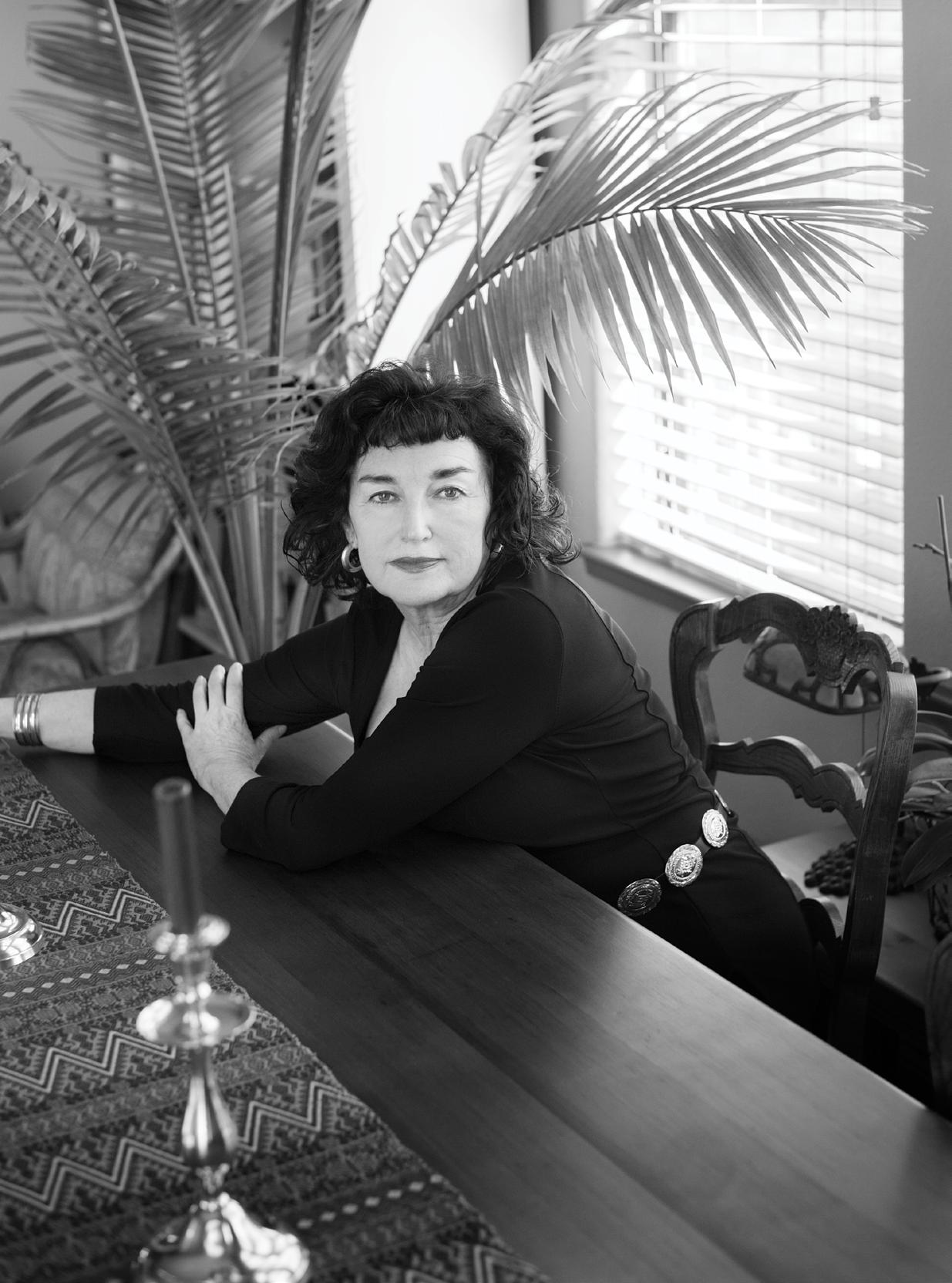
As someone who teaches writing, do you ever find yourself getting caught up in the mechanics of your own writing?
The best thing to do is let the work sit as long as possible… of course, not always easy when you’re on deadline. Ultimately you are able to come back to it with fresh eyes and edit it as if the material was written by a stranger. I’ve read passages from my memoir that were written years prior and said to no one in particular: “What the hell was she talking about?”
With your teaching schedule and life, where do you find time to write? What gets pushed aside?
I have found there is only one way to write while teaching: set the alarm early and start writing before all the demands of the day get their claws into me. Time is the greatest luxury, and yet most of us are not spending the majority of our time on the thing that’s our greatest priority. I am consciously trying to align those two facets of my life.
What gets pushed aside? Sleep.
What book would you give someone with the hope of inspiring greatness?
My latest book, Champion of Choice, the biography of UN leader Nafis Sadik. My belief during the ten years I was working on Champion—and the thing that sustained me along that rocky road around the globe—was that readers dissect biographies to learn how to improve their own lives. Nafis has changed the world, and so I used her story as a blueprint for women hoping to make dramatic political and social change, interviewing Nafis and other female leaders about the techniques they used. I even did a Ted Talk on this material: how to raise your daughter to be a world leader.
Content Magazine Literary Series is
curated
by Santa Clara County Poet Laureate David Perez
by Chad Hall
Photography by Daniel Garcia
CHAMPION OF CHOICE: THE LIFE AND LEGACY OF WOMEN’S ADVOCATE NAFIS SADIK
As our next client comes aboard, the Winnebago’s radio plays the old Del Shannon song “Runaway.” It’s an appropriate soundtrack for the evening’s drama, as St. Petersburg and Moscow are full of poor young Russian women, runaways who left their villages in search of opportunity and then wound up on these urban streets as hookers. Anna says she has seen some of their clients show up at the van for the past five years. “They used to be quite beautiful and you could carry on a conversation with them, talk to them for hours. Now you can see the degradation. They’re absent-minded and can only focus on getting drugs.”
While the music floods the cramped space, a twenty-five-year-old woman who looks like a Russian Liv Tyler with ripe pink pouty lips enters. Upon closer inspection I realize those luscious mounds are pushed out to full flower by rather feral-looking buck teeth. Her pupils are dilated so large that her eyes appear like black marbles, and she stares at me with the wild desperate look of a hurt animal. Anna asks if she needs a referral to the free clinic to be checked for the AIDS virus. Liv responds there’s no need. She already knows she’s HIV positive. This is not really a surprise, considering Russia has the world’s fastest growing HIV population.
As the night wears on, we stop for more clients. Lana, a twenty-one-year-old blonde enters the Winnebago clearly about to come out of her skin for need of a fix. She stands hunched, hopping from one foot to another, sucking air through her teeth as her eyes dart around the camper. Lana reveals she has the jitters for more reasons than one: she bought seven hundred rubles worth of heroin from her dealer on credit, and if she doesn’t have the money back to him today she’s in big trouble. It’s five minutes until midnight. She quickly takes her packet and exits the camper. But as we drive away we see the police stop and pull her into a squad car.
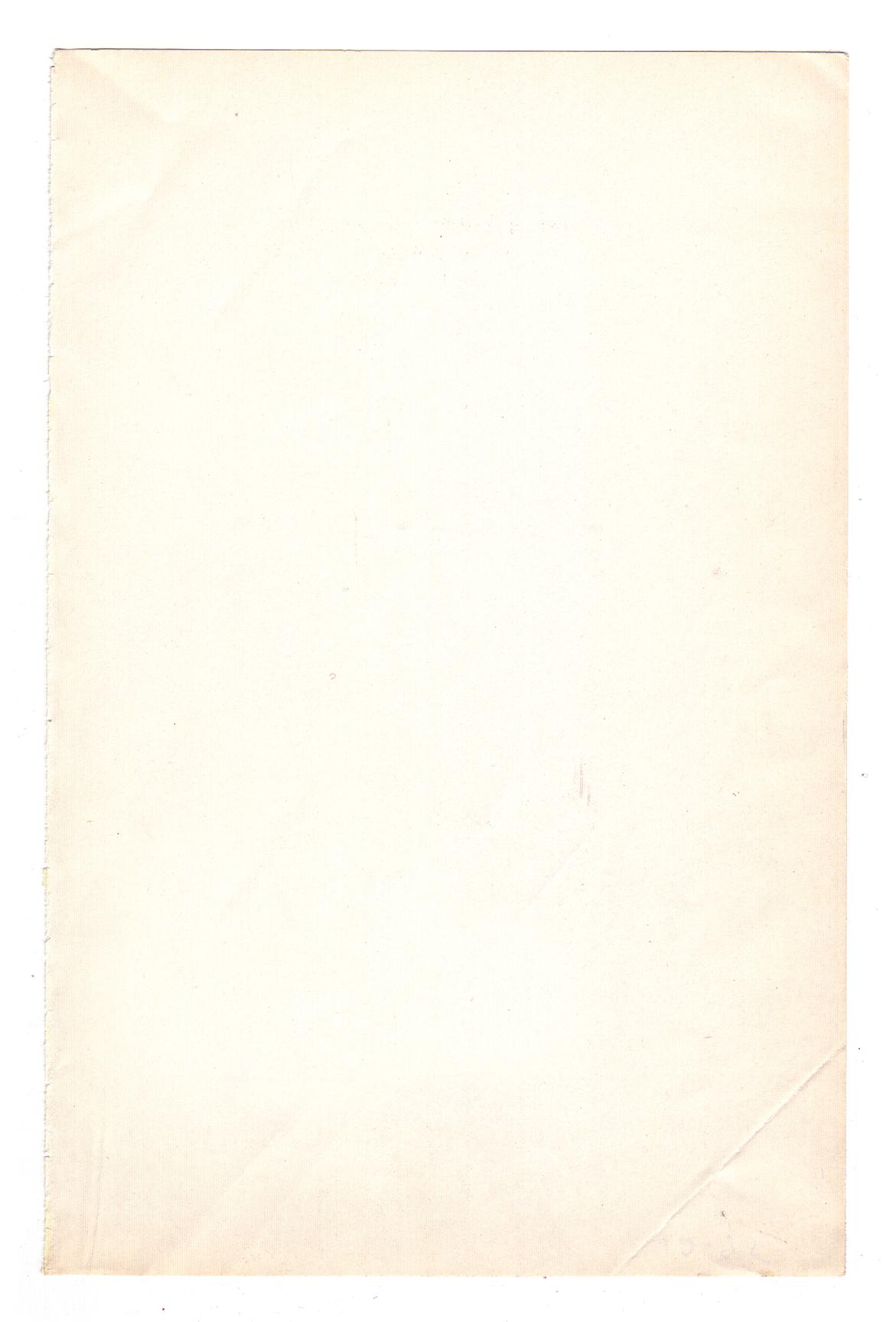
Excerpt by Cathleen Miller (University of Nebraska Press) 69
Cathleenmiller.info facebook: authorcathleenmiller
Cinequest Guide
Written by Nathan Zanon Movie stills provided by Cinequest
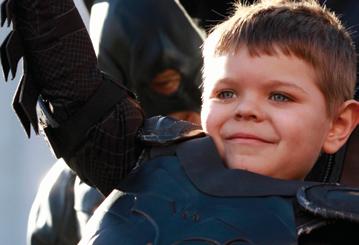


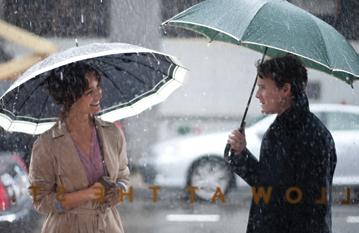
The 25th Cinequest Film Festival kicks off on Tuesday, February 24, and runs through Sunday, March 8. That’s 13 solid days of movies, parties, forums, and events that will turn downtown San Jose into a hub of activity. So, how do you know what to focus on during the festival? Don’t worry: follow our handy guide and you can’t go wrong.
OPENING NIGHT
Yes, it’s a Tuesday, but the film and party on opening night are worth staying up past your usual bedtime for. Expect some inspirational opening comments followed by the documentary Batkid Begins, taking place at the gorgeous California Theatre. Afterwards, head to the kickoff party for food and libations.
INTERNATIONAL CINEMA
Hundreds of excellent films are released around the world each year, but only a few trickle into American theaters or find their way onto Netflix. Cinequest shines when it comes to international cinema, showcasing unique films that bring new viewpoints to stories that have often been turned into cliches in Hollywood.
SHORT FILM PROGRAMS
Film festivals are one of the only chances you’ll have to see great curated short film programs, so take advantage! Often overlooked by the mainstream, short films contain storytelling that is powerful, insightful, and cleverly imagined. Recommended: Animated Worlds (Program 4-includes the Oscar-nominated The Dam Keeper), DocuNation (Program 6), and Student Shorts (Program 8).
MAVERICK MEET-UPS
After a day of films, what’s better than grabbing a drink with fellow movie lovers and chatting about what you’ve seen? Each night, the designated Maverick Meet-Up location is the place to go to socialize and maybe even meet the stars and directors of the films you’ve just watched.
MAVERICK SPIRIT AWARD WINNERS
These are often announced closer to the festival date, so keep an eye out to see which film luminaries will receive the Maverick Spirit Award this year. More are often announced closer to the festival date, but this year’s Maverick Spirit Award recipients include Rosario Dawson and writer/director/producer John Boorman. Recent past honorees have included Harrison Ford, Salman Rushdie, and Chuck Palahniuk.
DOWNTOWN SAN JOSE
While you’re downtown for the festival, explore beyond the Cinequest bubble: visit a local bar or club for a show or try out one of the many excellent restaurants in the area. March 6 is the South First Friday Art Walk, so galleries will be open late and there will be a festive atmosphere on the streets. Take a break from the big screen!
CLOSING NIGHT
When the festival wraps up, don’t miss the closing film (5 to 7) and the blowout afterparty. The dance floor will be lively, the sponsored booze will be flowing, and you can say a teary goodbye to all of the actors, directors, and new best friends you met during the previous two weeks.
70

Contributors
The production of Content Magazine would not be possible without the talented writers, editors, graphic artists, and photographers who contribute to each issue. We thank you and are proud to provide a publication to display your work. We are also thankful for the sponsors and readers who have supported this magazine through advertisements and subscriptions.
Want to be a part of the Content community?
Contact us at:
Editor@content-magazine.com
JAY AGUILAR
Jay is a Polaroid photographer and Polaroid lover from the South Bay who does anything to ‘get the shot.’ He attends art and musicshow events throughout the Bay Area to capture melodies and memories with Impossible Project’s newest generation of Instant Films. instagram/twitter: AbcdefghiJayJay
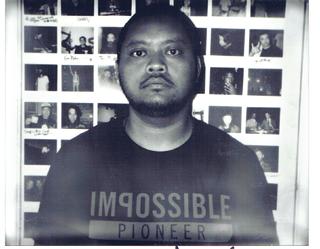
GUSTAF FJELSTROM
Gustaf is an artist, musician, creative director, and San Jose native. After studying illustration at SJSU, he spent the next fifteen years in the South Bay agency scene. His newest challenge takes the shape of Creative Director at WestGate Church.

twitter: botched
ODILE SULLIZAN-TARAZI

Odile has worked the last 25 years as an editor and a writer in Silicon Valley’s high-tech industry. In coming to Content Magazine, she returns to her roots in the arts and humanities. And to designing reader experiences that, as well as being informative, are rich, full, and pleasurable.

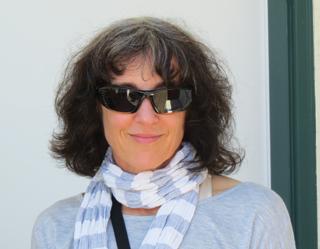

Omar has lived in San Jose for over 20 years. He owns and operates Kooltura Marketing, and is specifically motivated by multicultural marketing and branding.

twitter: kooltura
KEVIN ZITTLE
Kevin is a California-based photographer and designer. He’s an artist at heart and a maniacal technical genius to those who don’t know better. In his spare time, Kevin volunteers in the community, collects fine guitars, brews fine craft coffee, and criticizes bad typography.
twitter: kevinz
JOHN AGCAOILI
John is a Bay Area–based photographer and cinematographer. He actively participates and produces community-based collaborations for the arts, has been published at an international level, and is co-founder of the creative team DSOTM.

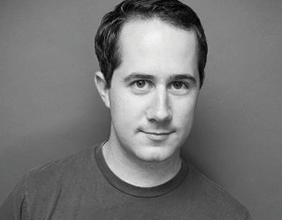
ANNA
Anna is a Bay Area–based social media and marketing professional by day. At heart she is writer, storyteller, and comic. Her passions are the written word, music, and the beach. In her spare time she watches documentaries, drives Highway 1, and searches local farmer’s markets for that perfect heirloom tomato.
KRISTEN PFUND
Kristen is a producer and creative consultant in the Bay Area, with a split interest in the art of film and photography. As an avid international traveler, she’s compelled to tell cultural, visual stories that are both thought-provoking and empower people to take action.
 BAGIROV
BAGIROV
72
OMAR RODRIGUEZ
Proud Sponsor of Content Magazine Pick Up Parties for 2015
If you are reading this, you’ve probably been to a Filco event.
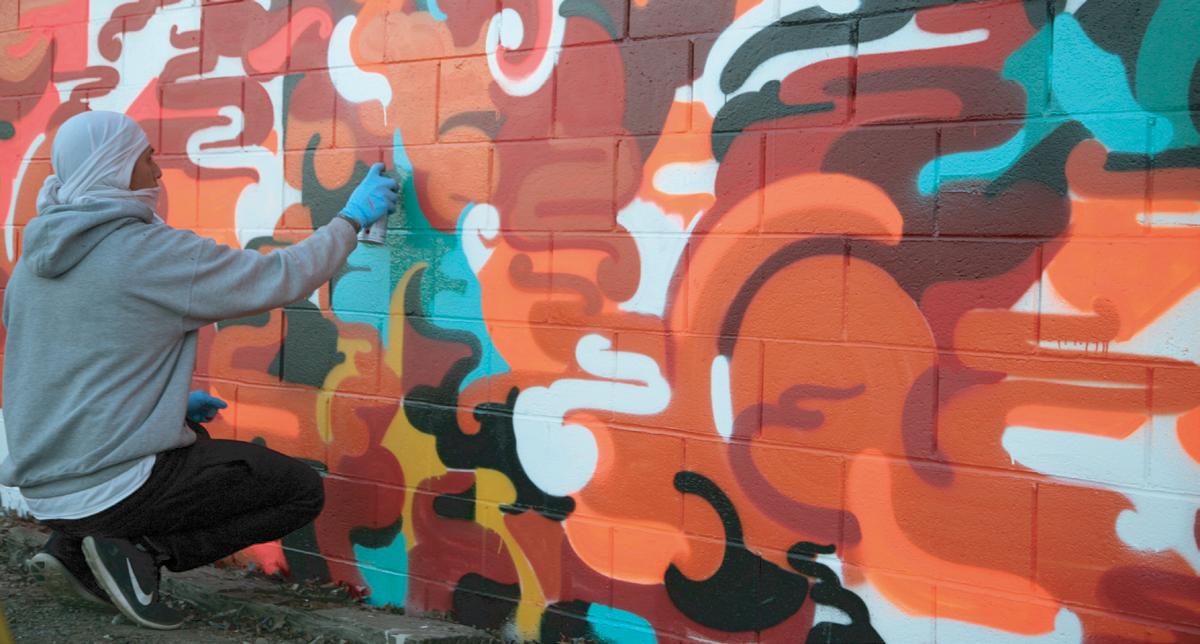
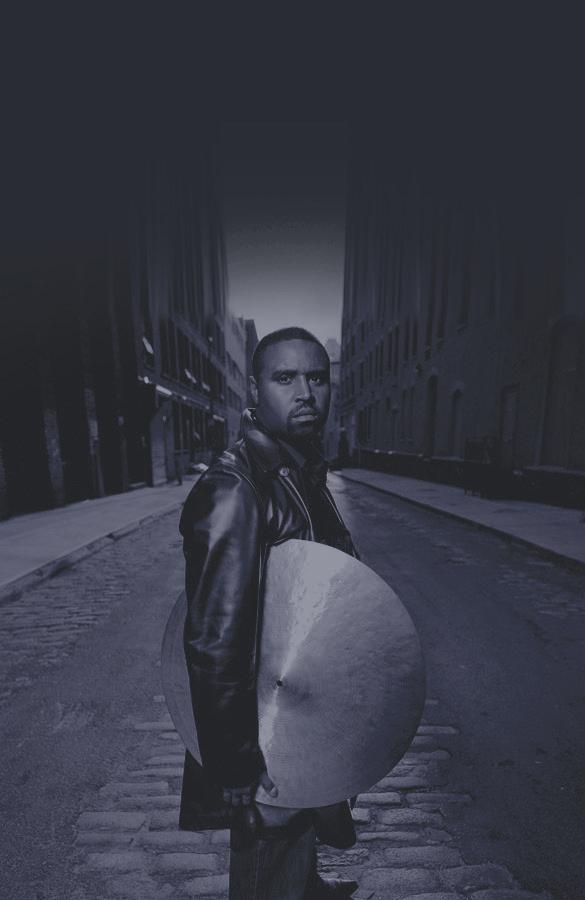

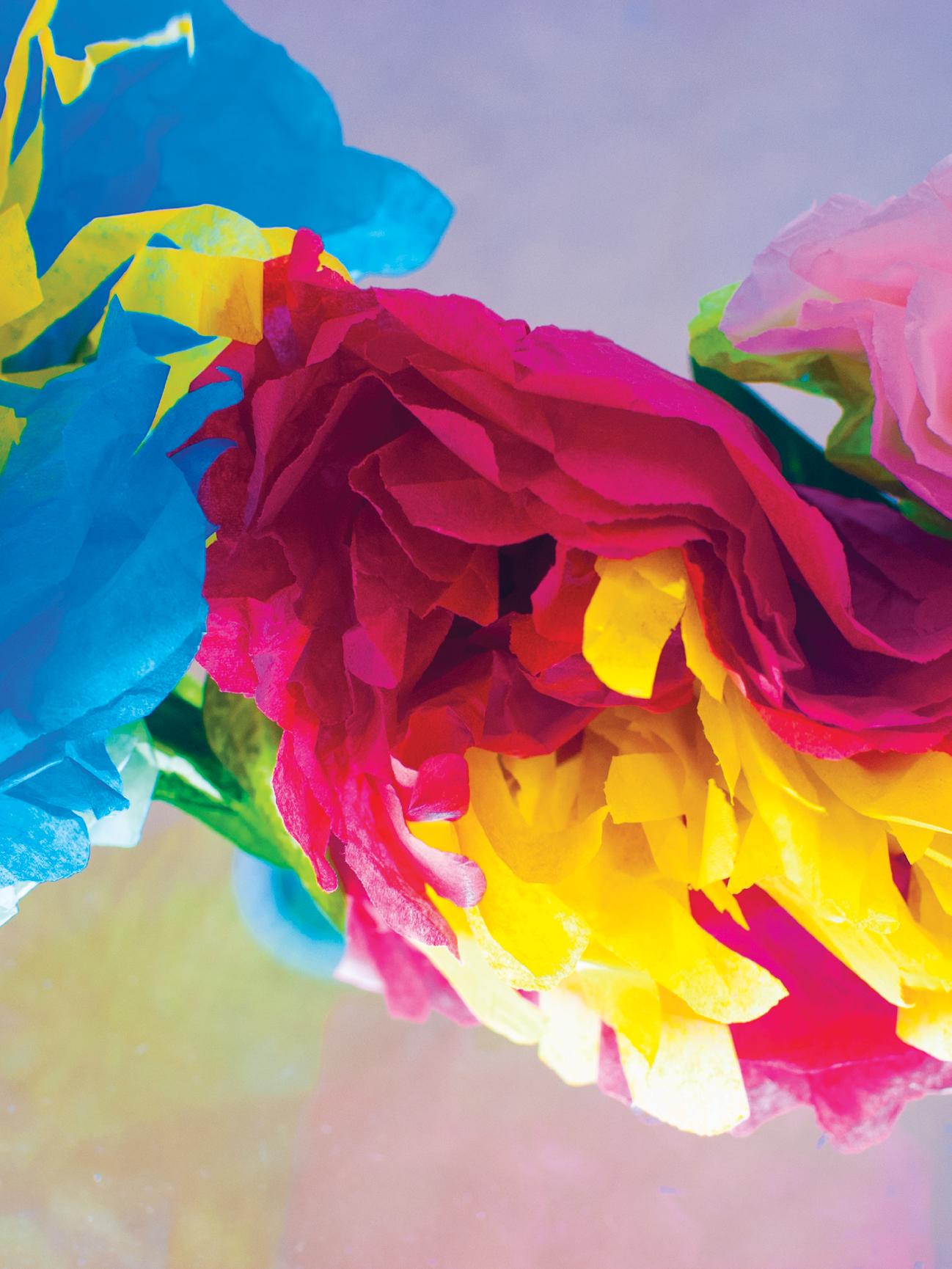
KOOLTURA MARKETING KOOLTURA.COM #KOOLTURA



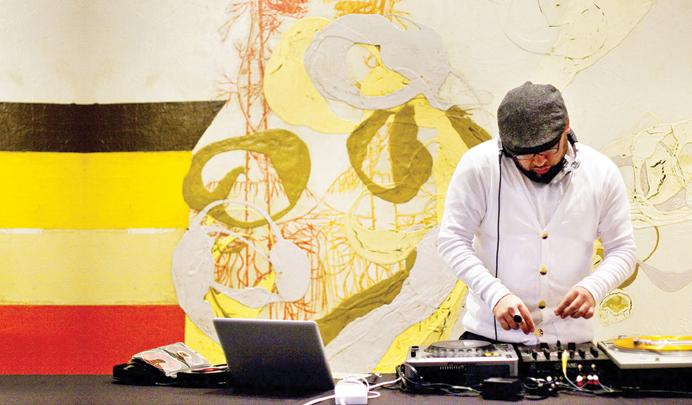
SJ | LA NINICOCOMMUNICATIONS.COM from actors to architects. Public Relations Brand Strategy Adver tising





CONTENT
ca
CONTeNT NEXT ISSUE
SAN JOSE 2015
WWW.CONTENT-MAGAZINE.COM facebook.com/contentmag
twitter.com/contentmag
ANNuAl subsCripTiON priNT $42.00
Sight and Sound 7.1
INNOVATIVE
silicon valley’S
& CREATIVE CULTURE made in sanjose,
























































 Cain Ramirez
Amanda Muehlbauer
Photographed at La Dolce Velo Bicycle Shop 1280 The Alameda, San Jose, CA 95126
Cain Ramirez
Amanda Muehlbauer
Photographed at La Dolce Velo Bicycle Shop 1280 The Alameda, San Jose, CA 95126












 $110
Top - Olivaceous, Prim, Los Gatos $58.50
Gatos $98.50
Necklace - Lotus, Los Gatos $76
Swirl Silver Ring - Karine Sultan, Black Cat Hats, Los Gatos $25
Cross Ring - Flying Lizard, Santana Row $67.50
$110
Top - Olivaceous, Prim, Los Gatos $58.50
Gatos $98.50
Necklace - Lotus, Los Gatos $76
Swirl Silver Ring - Karine Sultan, Black Cat Hats, Los Gatos $25
Cross Ring - Flying Lizard, Santana Row $67.50
 Top - Lotus, Los Gatos $46
Pants - Nikibiki, Lotus, Los Gatos $38
Ring Set - Lotus, Los Gatos $36
Earrings - Anna Sukardi, Blū Cielo, Palo Alto $50
Top - Lotus, Los Gatos $46
Pants - Nikibiki, Lotus, Los Gatos $38
Ring Set - Lotus, Los Gatos $36
Earrings - Anna Sukardi, Blū Cielo, Palo Alto $50
 Jacket - Line, Rouge, Los Gatos $621
Skirt - Lotus, Los Gatos $42
Earrings - Flying Lizard, Santana Row $60
Jacket - Line, Rouge, Los Gatos $621
Skirt - Lotus, Los Gatos $42
Earrings - Flying Lizard, Santana Row $60
 Top - Olivaceous, Prim, Los Gatos $58.50 Pants - Articles of Society, Prim, Los Gatos $98.50
Shoes - Donald J Pliner $575
Necklace - Lotus, Los Gatos $76
Cross Ring - Flying Lizard, Santana Row $67.50
Top - Olivaceous, Prim, Los Gatos $58.50 Pants - Articles of Society, Prim, Los Gatos $98.50
Shoes - Donald J Pliner $575
Necklace - Lotus, Los Gatos $76
Cross Ring - Flying Lizard, Santana Row $67.50
 Romper - Charlie Jade, Lotus, Los Gatos $266 Earrings - Anna Sukardi, Blū Cielo, Palo Alto $75
Romper - Charlie Jade, Lotus, Los Gatos $266 Earrings - Anna Sukardi, Blū Cielo, Palo Alto $75






 Photography by Daniel Garcia
Photography by Daniel Garcia




























 BAGIROV
BAGIROV











